David Bridgwater wrote to me a few weeks ago. He had read the art book that I published with Yale, Owning the Past, about the English collectors who scoured Italy, Greece and Turkey for antique sculptures in the eighteenth century and brought them back to furnish their country houses. He said that he had quite a nice house in Bath, and a special interest in eighteenth century English portrait sculpture. He suggested that I might like to visit. Three weeks ago I did.
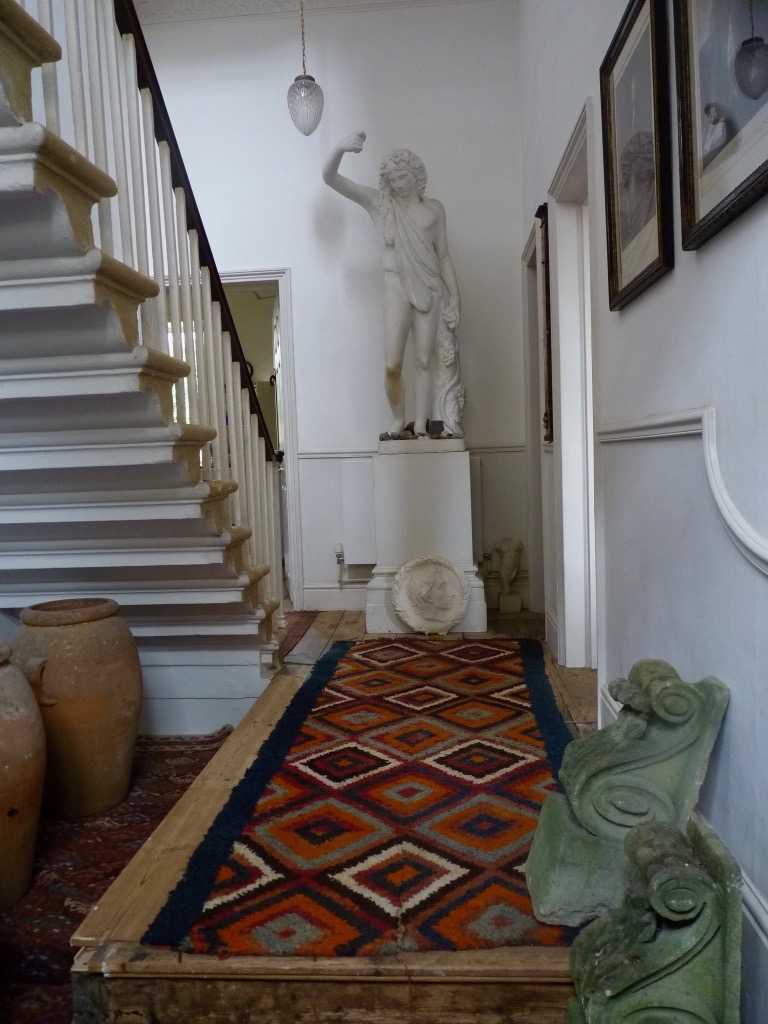
David is a historian cum dealer, who buys beautiful things whenever he finds them, to keep or to sell. But like me, he has a prodigious interest in the provenance of every object that he finds. A lot of his time is spent reading, researching and traveling in order to build up a backstory or identify the artist-creator connected with what he finds, and what he knows is published on his two blogs, one about eighteenth century portrait sculpture: https://english18thcenturyportraitsculpture.blogspot.co.uk and the other about the architects who built the houses and streets where he lives – https://bathartandarchitecture.blogspot.co.uk/ This is the entrance hall of his townhouse in Bath.
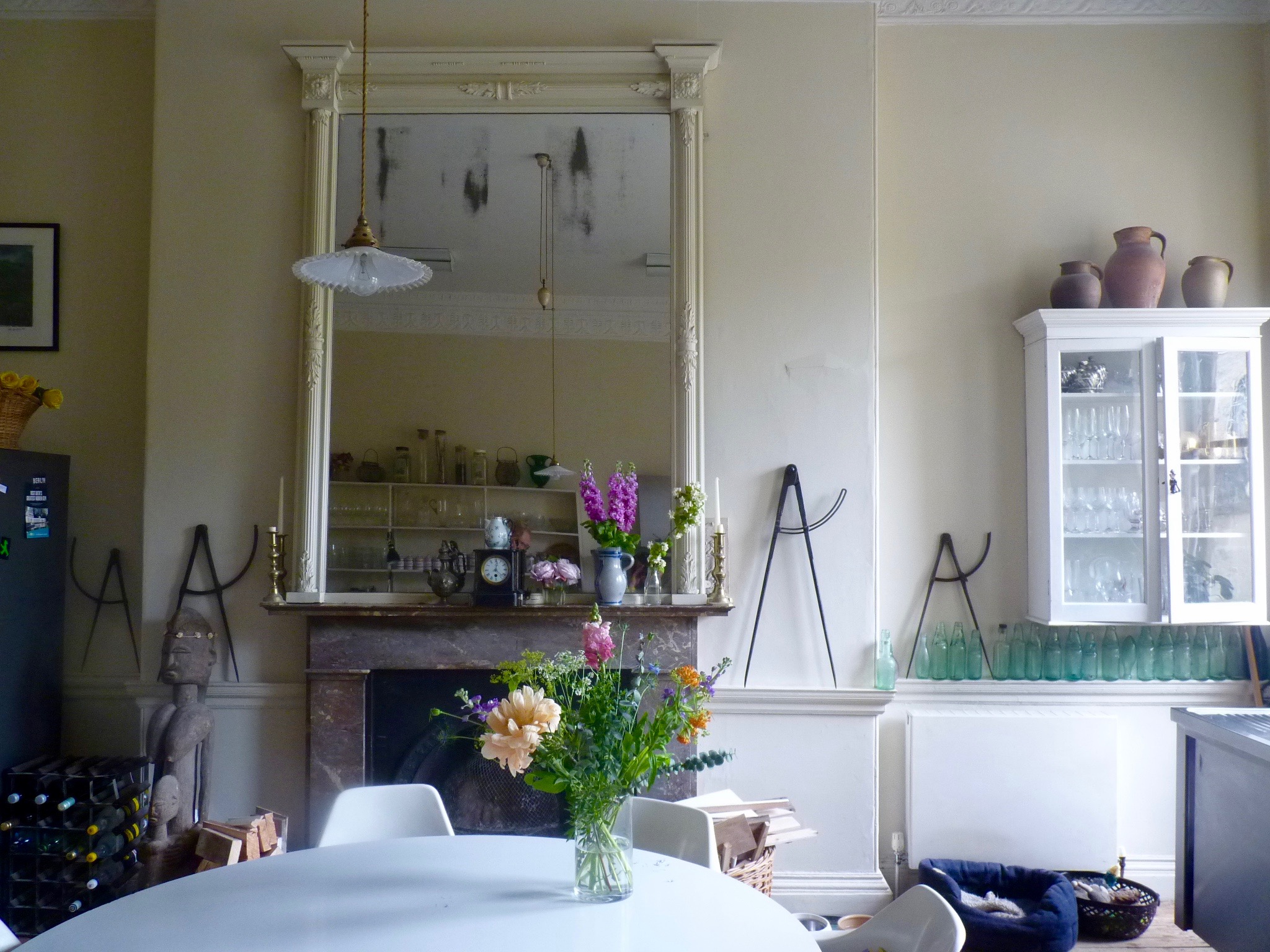
David and his wife Sarah came to live here 8 years ago, moving from a slightly older house a few streets away ( their two children are both grown up). This house, dated 1792 and designed by Thomas Baldwin as part of the Pulteney Estate, ranks among the finest of Bath’s very elegant Georgian housing stock. According to a bronze plaque on the facade it was home to William Pitt the Younger in 1806 – the longest-nosed of all the English Prime ministers by far. Here is their fabulous high-ceilinged kitchen.
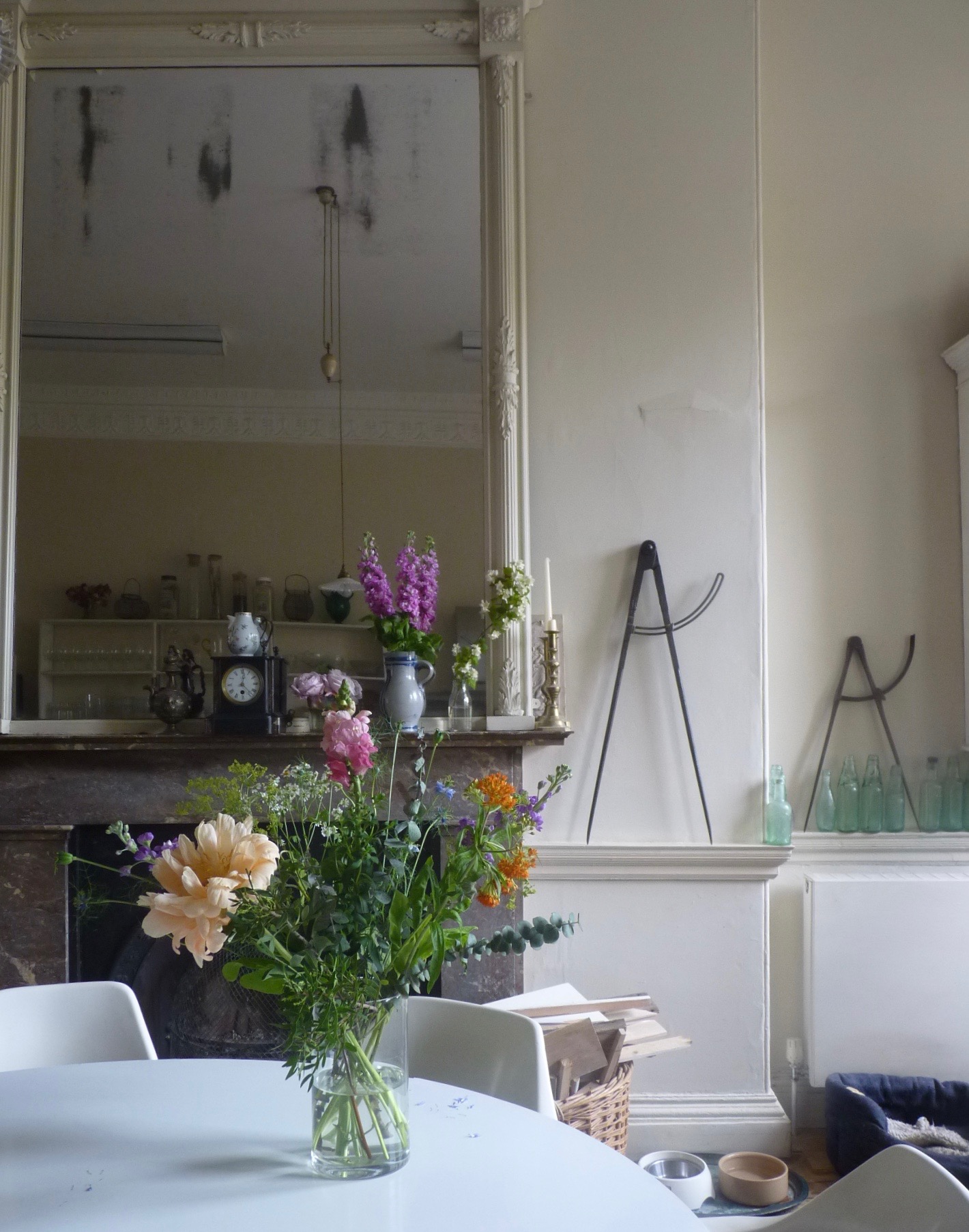
The house’s previous use had been as offices. ‘When we came here all this was smothered with two centuries of paint, it was three years on and off putting it back together. Nothing could have been done without my wife Sarah. There were strip lights like these everywhere. We left these ones. You can see what you’re looking for!’ (You can see one reflected in the looking glass)
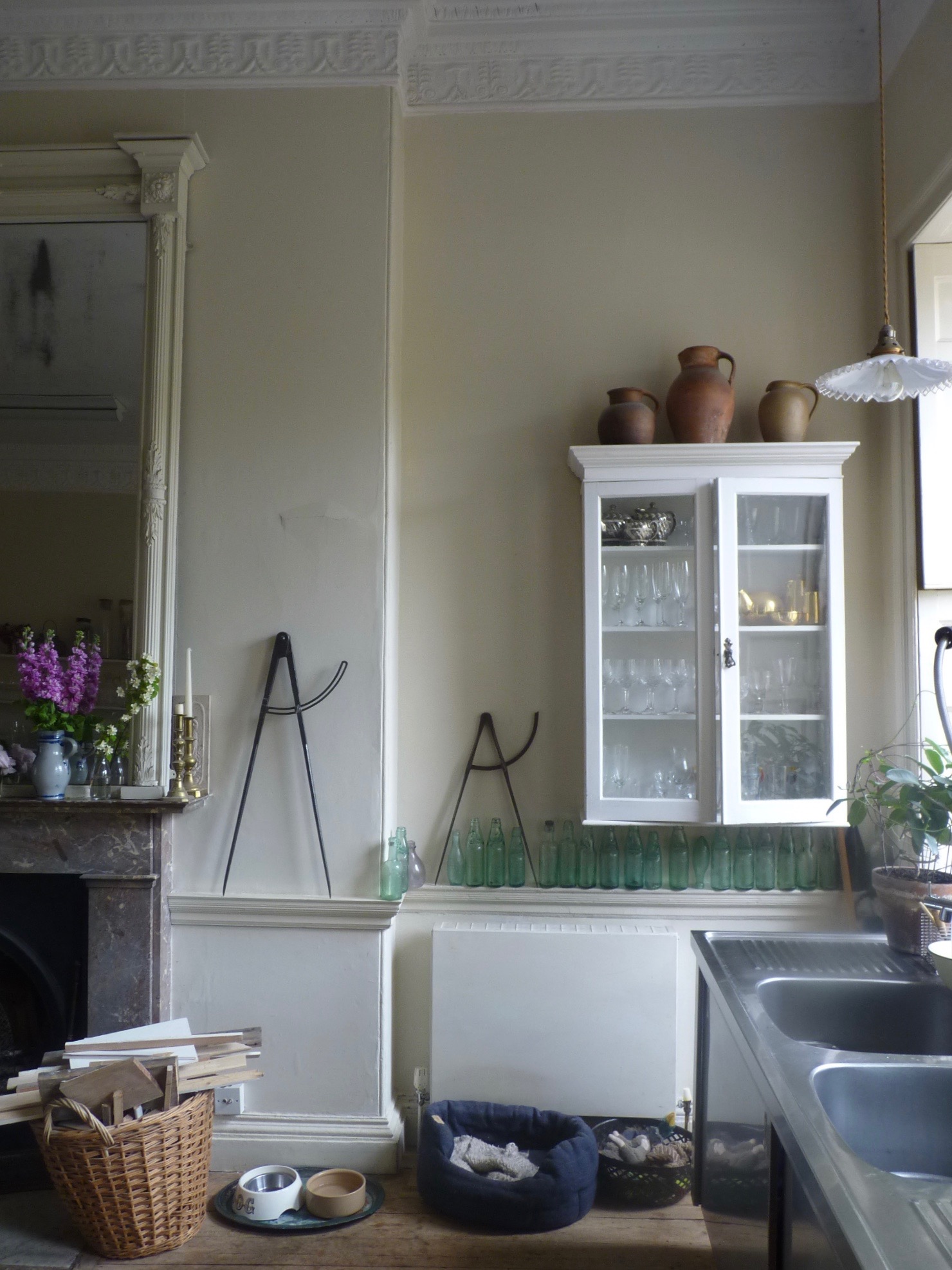
Industrial double sink unit with the dog bed belonging to their small hairy Griffon Bruxelloise Lulu, who is keeping well out of shot

Lulu, at bay
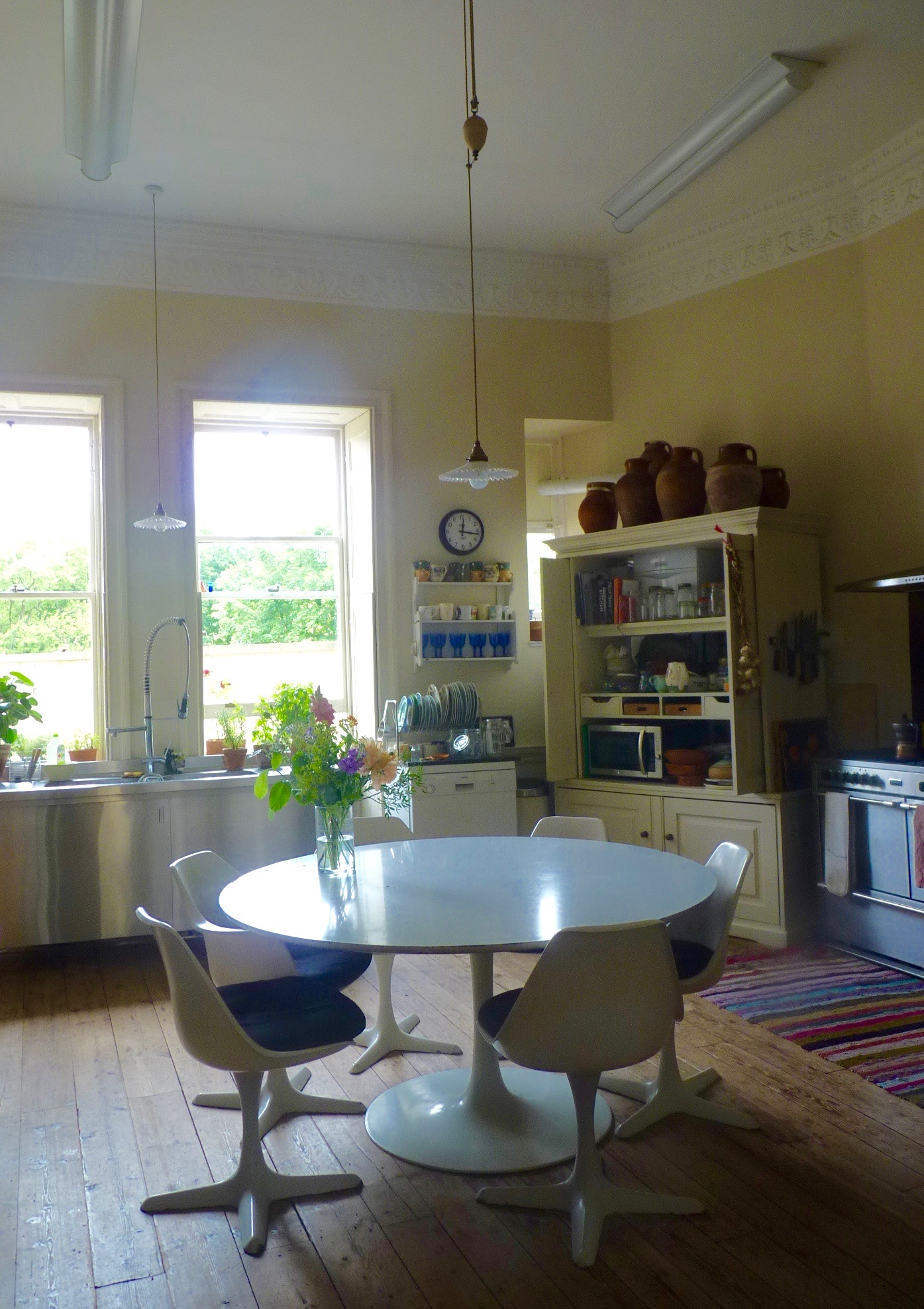
This kitchen is gloriously big.
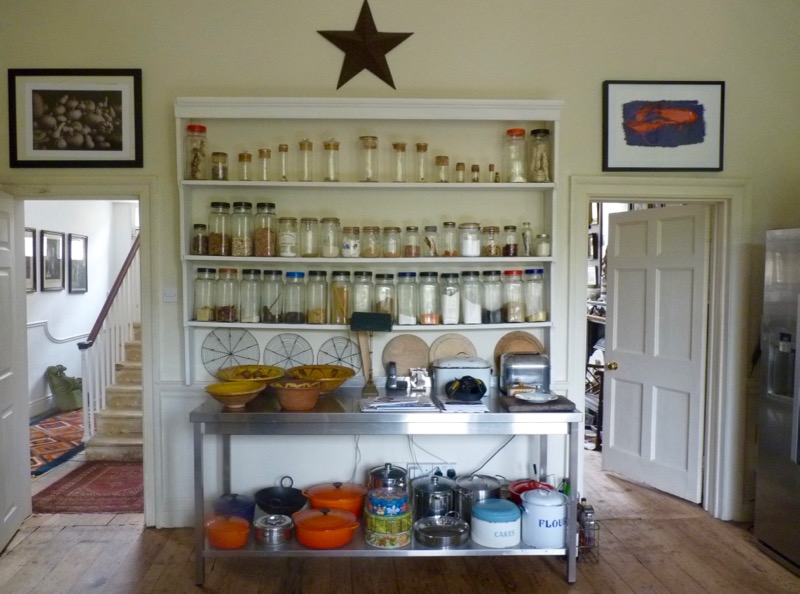
Each piece of furniture stands about 10 feet apart from the others.
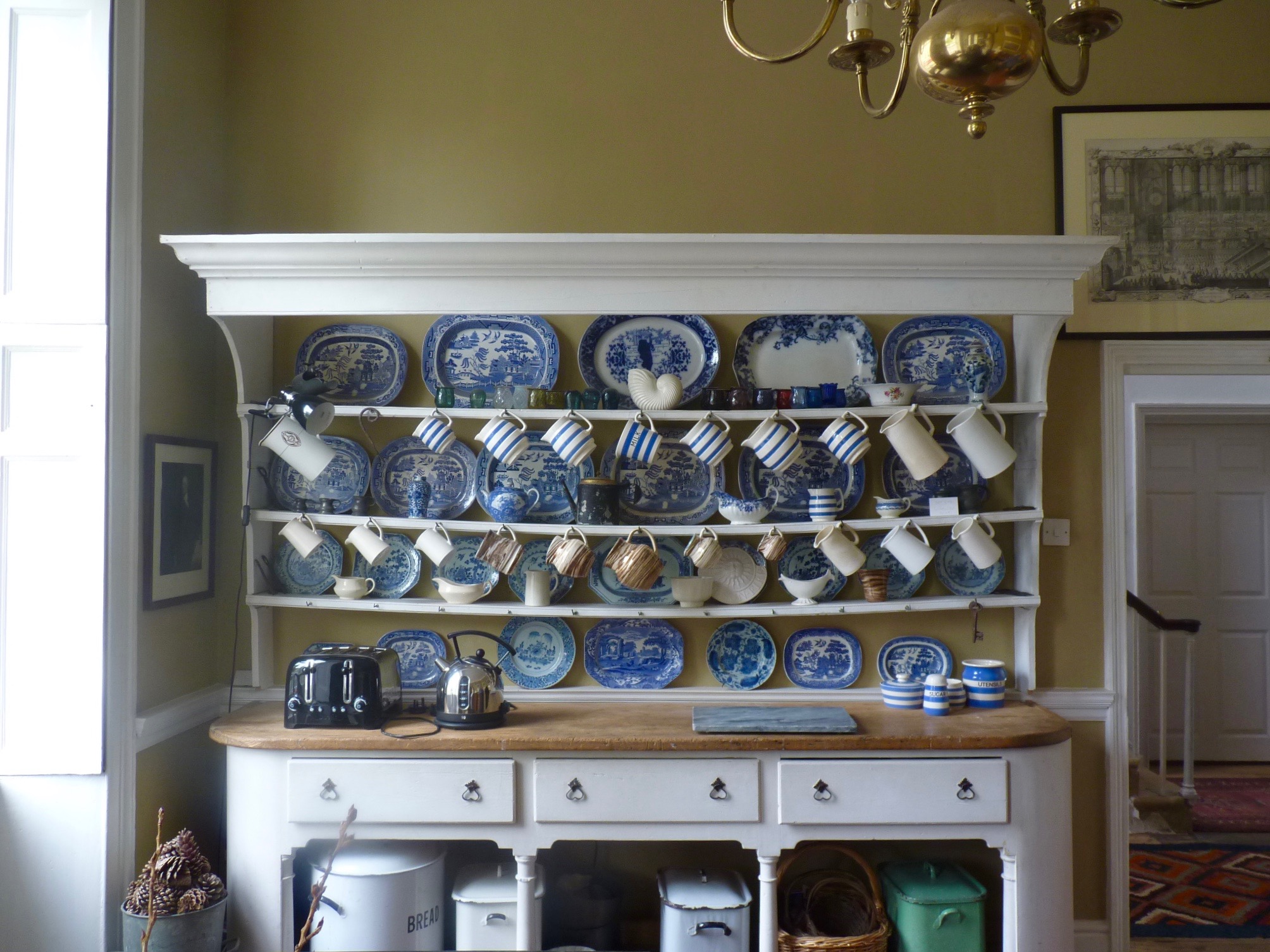
‘When we lived in a 1760s house in Walcot Street the kitchen was in the basement, so I stripped off all the old wallpaper and there was the silhouette of the original kitchen dresser marked on the wall. So I had this dresser made to measure, specifically for that wall.’ Now it does service in the Dining Room.
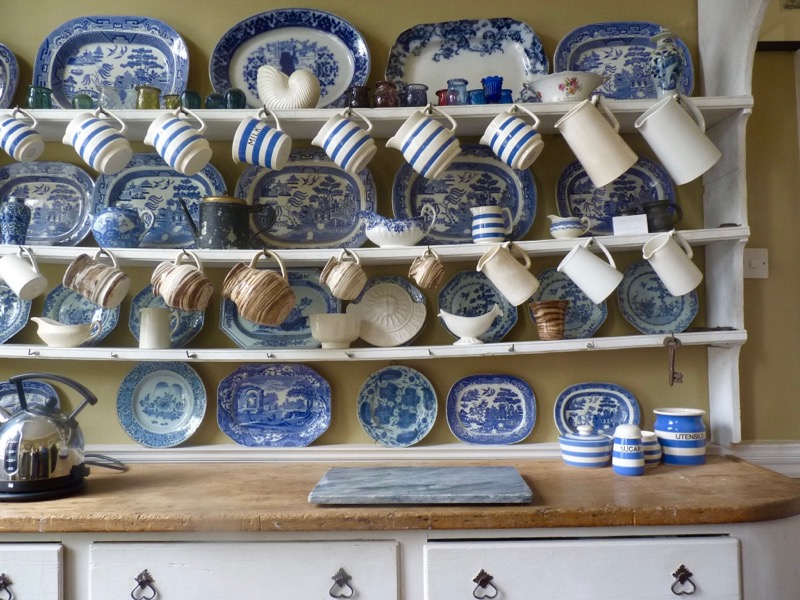
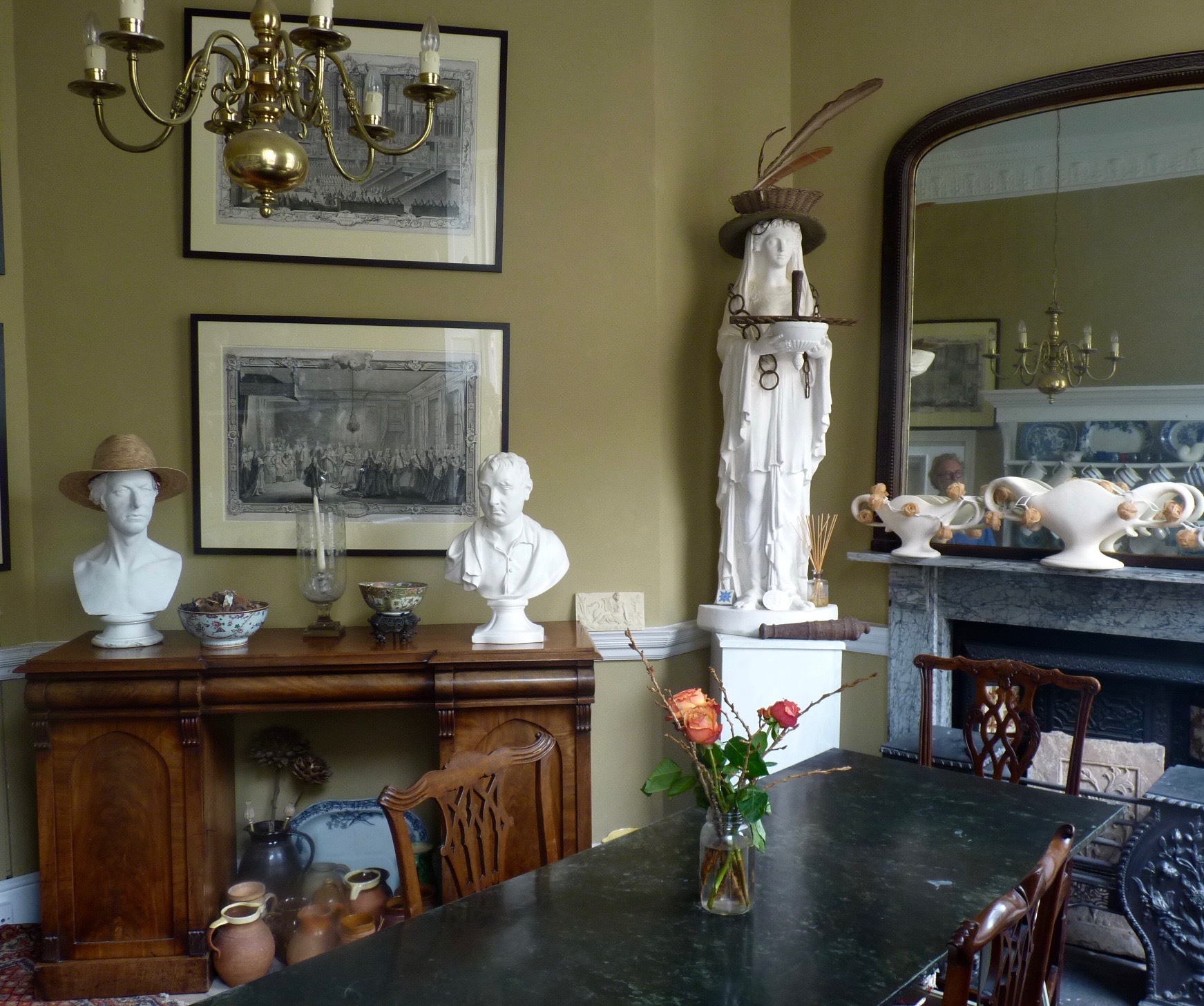
The Dining Room, plaster bust of William Pitt the Younger on the left.
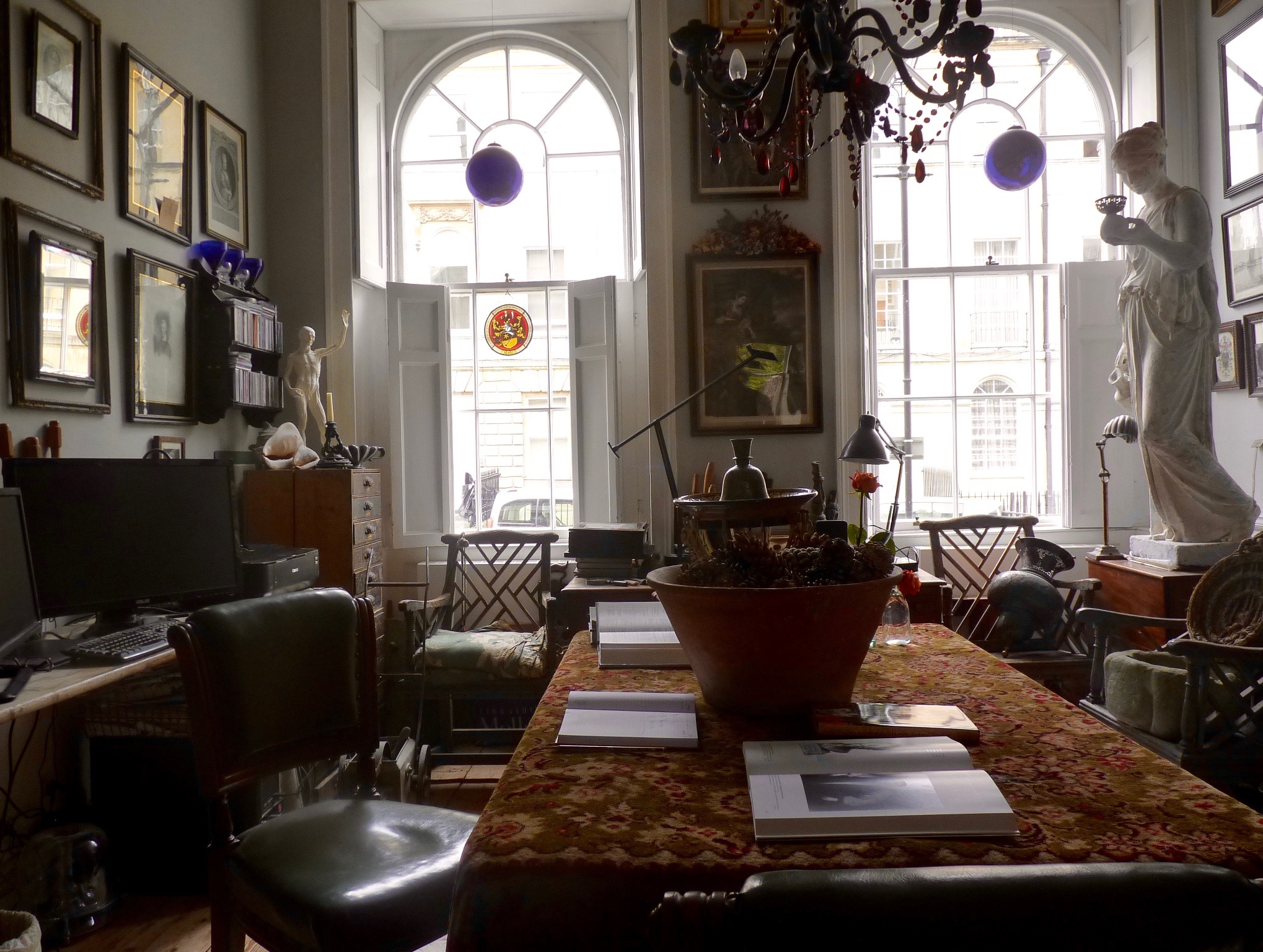
Now for something really special, David’s ground floor study.
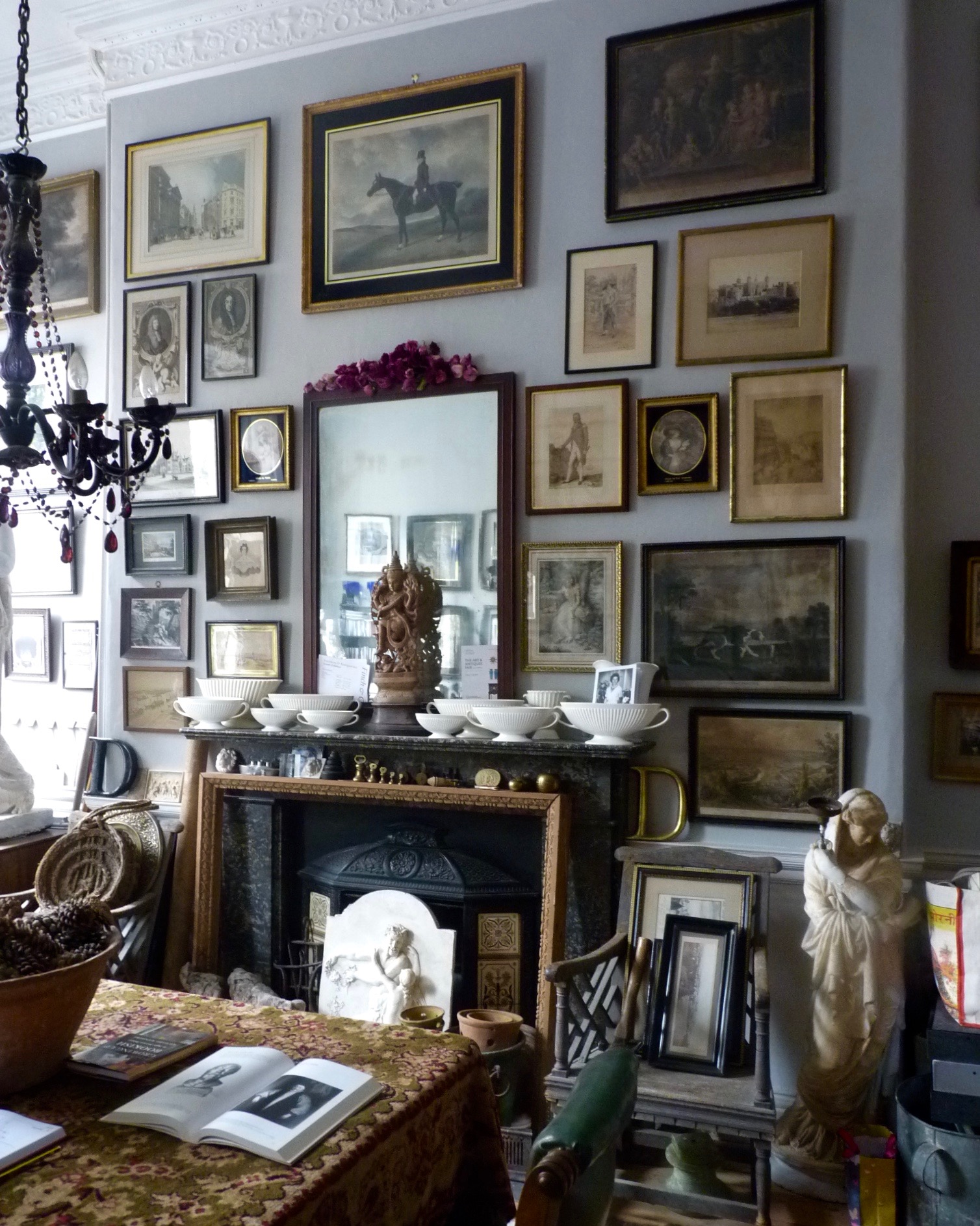
The chimney piece has a garniture of Wedgwood flower vases, the two-handled urn shape favoured by Constance Spry.The big one on the far left is not by Wedgwood tho. I particularly liked it, David didn’t.
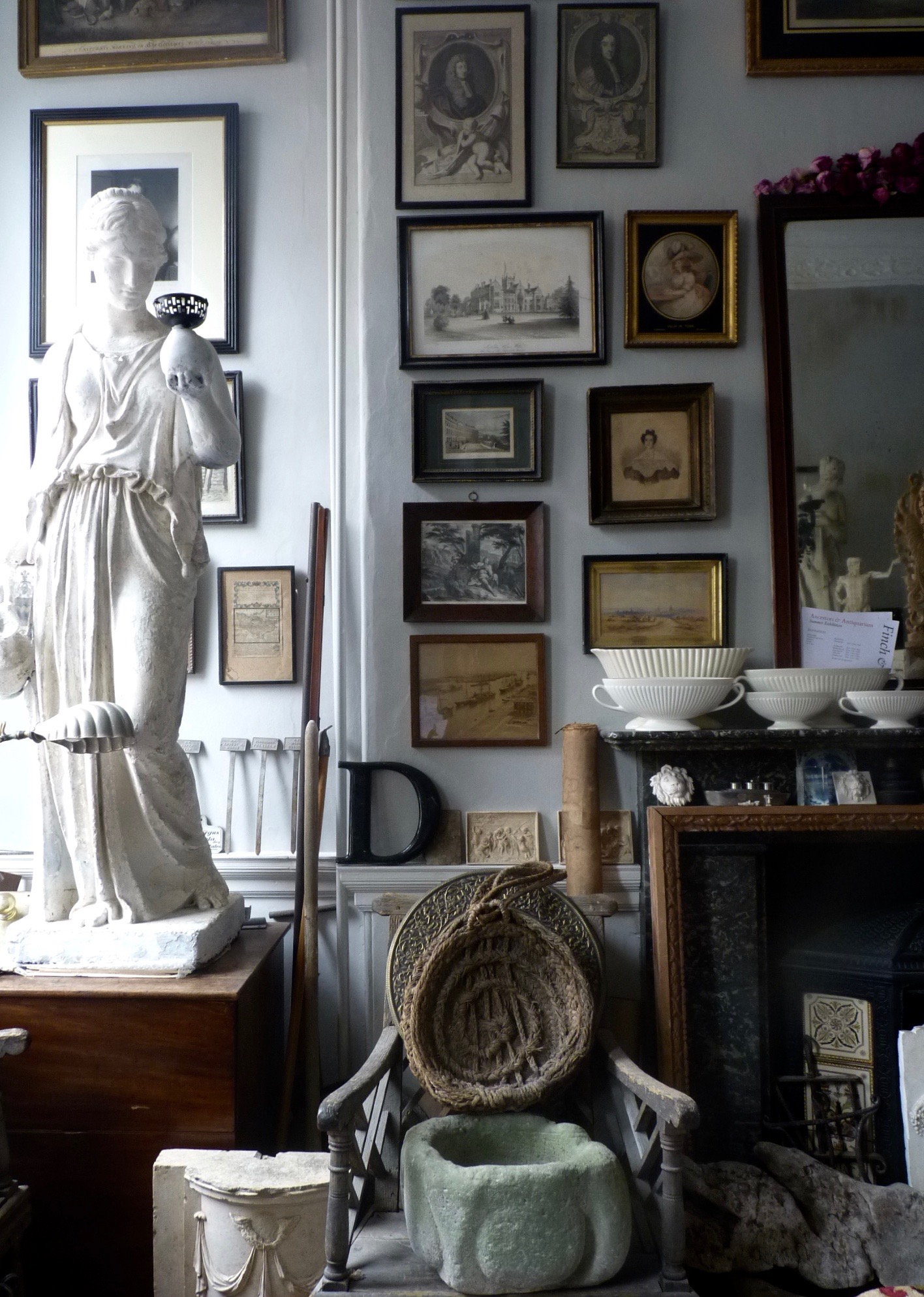
These fabulous garden chairs, now heavily weathered, are actually copies of an antique original. They were sold long ago from the famous Clifton Nurseries in London’s Little Venice, where self-styled ‘Master Plaster Caster’ Peter Hone managed the business dealing in fabulous sculpture and garden antiques. (David Bridgwater ‘got into gardens back in the 80s’ too.) There are a few of Peter’s plaster casts here amongst much older things. Peter says he’s taken more casts than a ‘Pea podder has podded peas in a pea podding factory’. You can buy his casts from Pentreath and Hall, and see their ‘Hone Museum’ of casts filling the back wall of the Rugby Street shop.
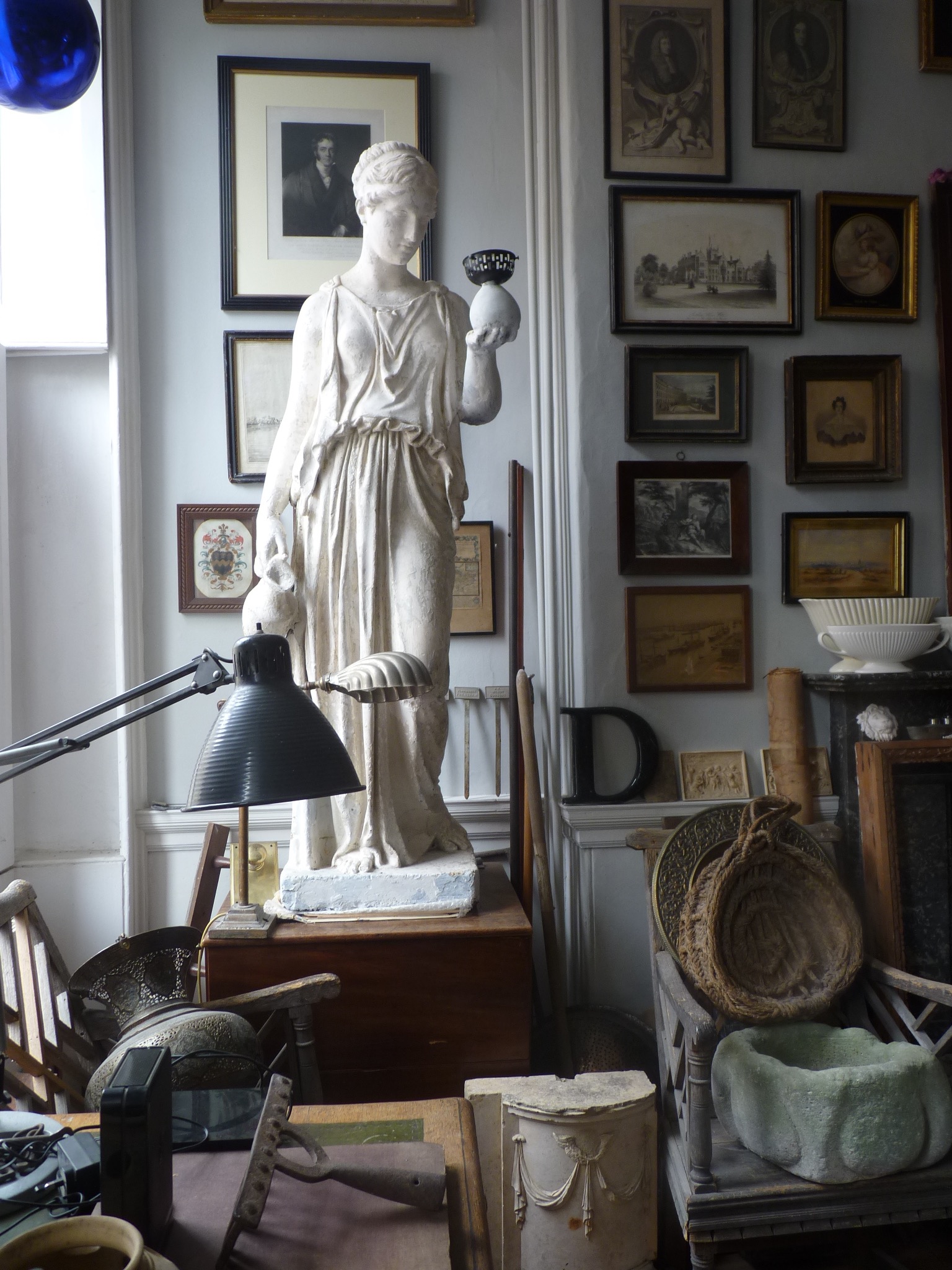
.
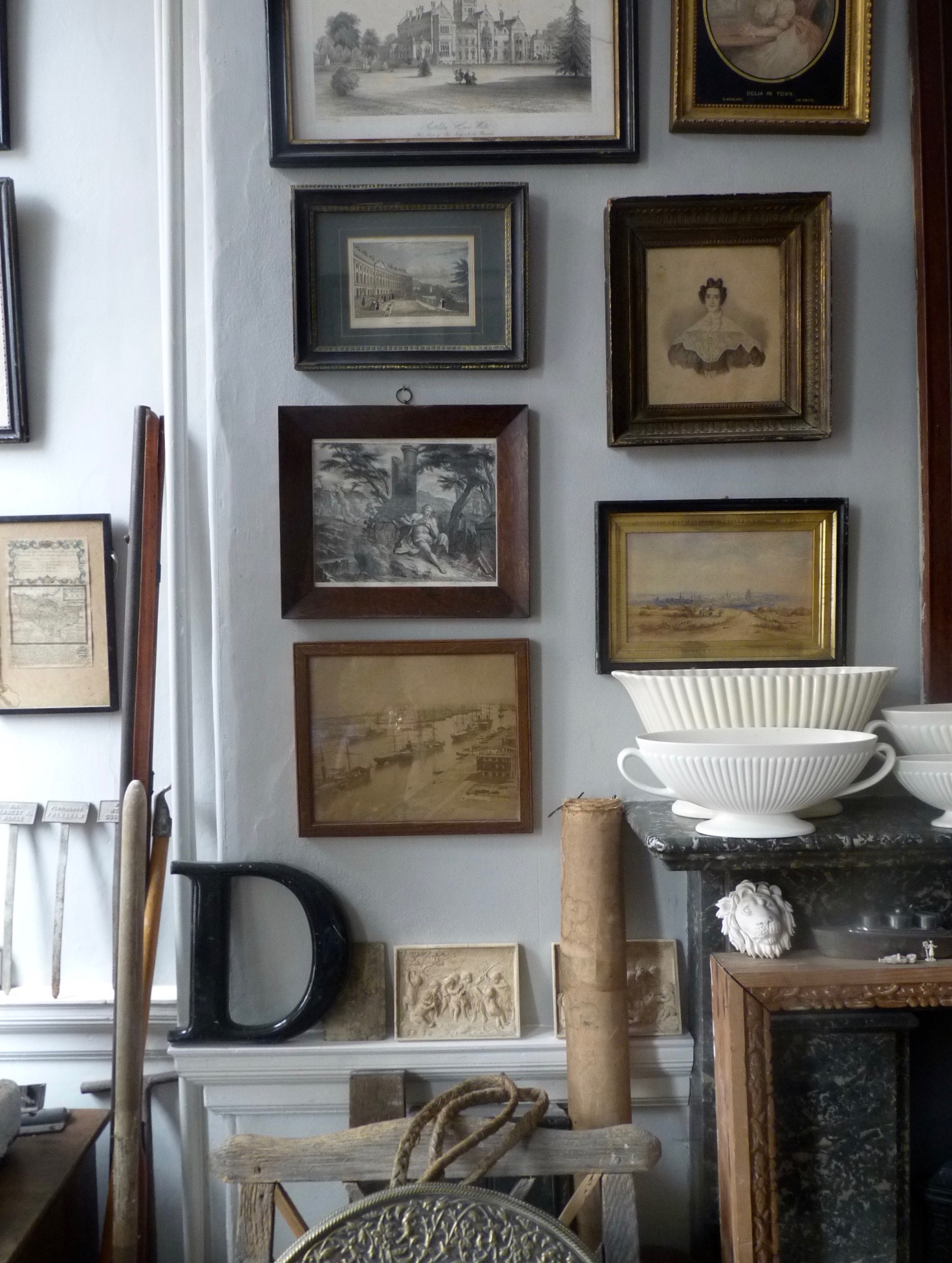
Old metal plant labels arranged along the dado rail.
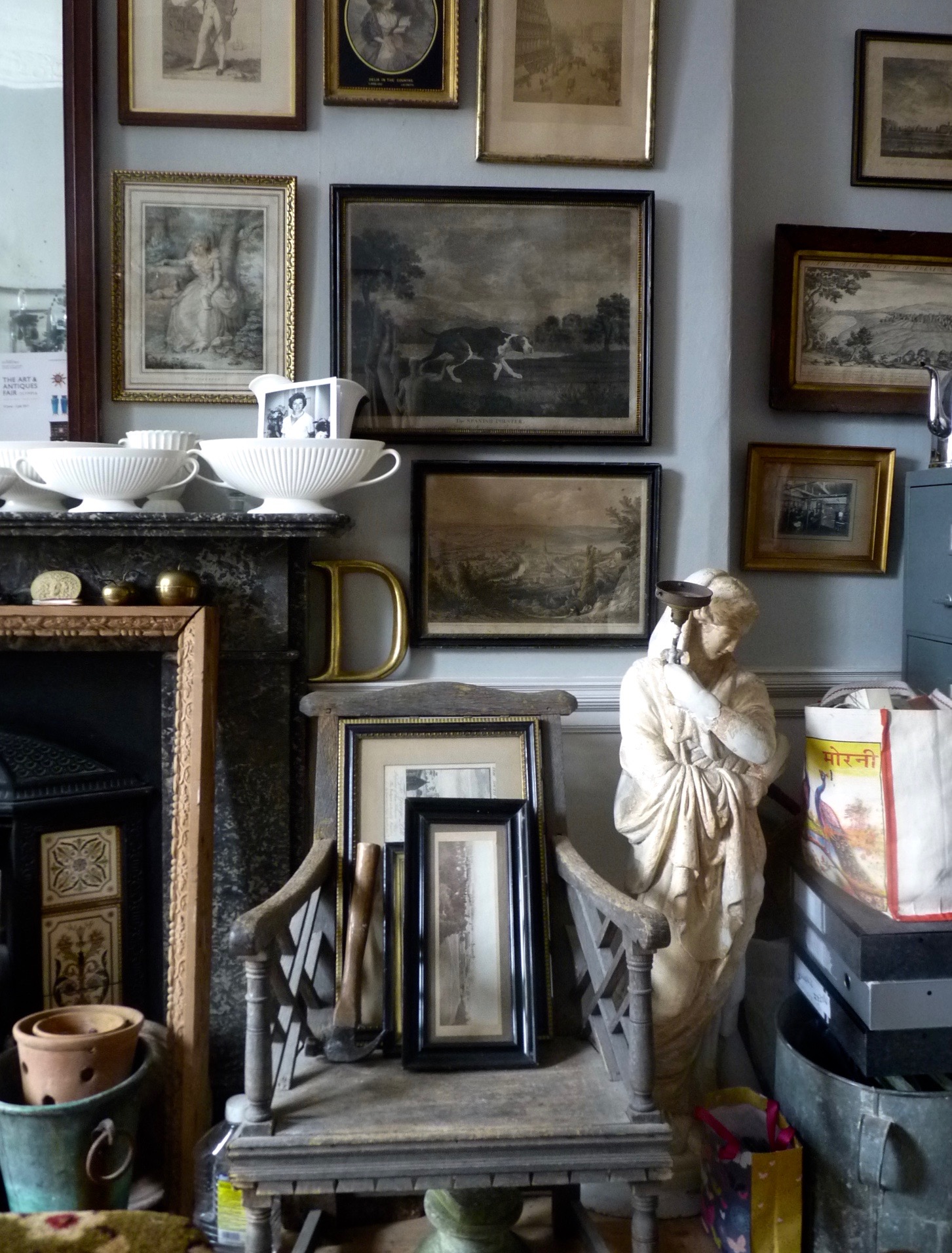
.
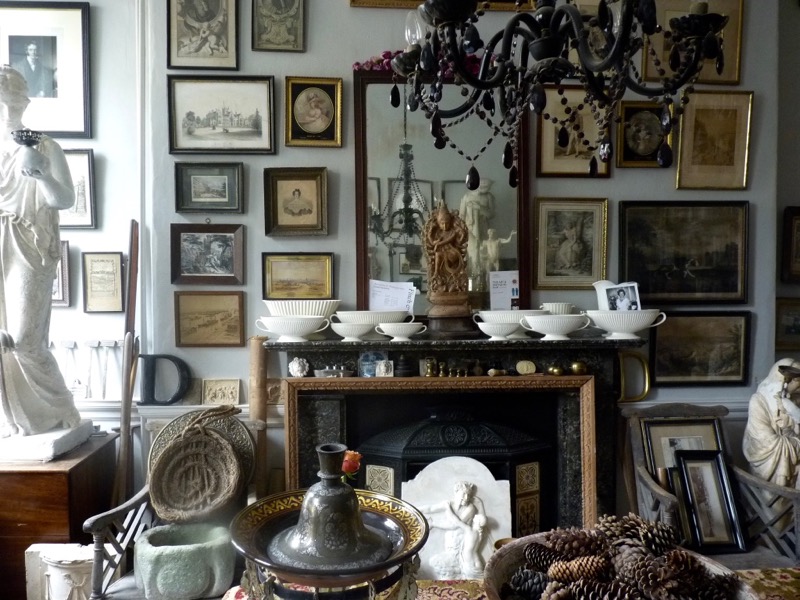
A fabulous piece of eighteenth century Bidriware from India in the middle of the table, the base of a hookah pipe, inlaid with a silvered design of poppy heads.
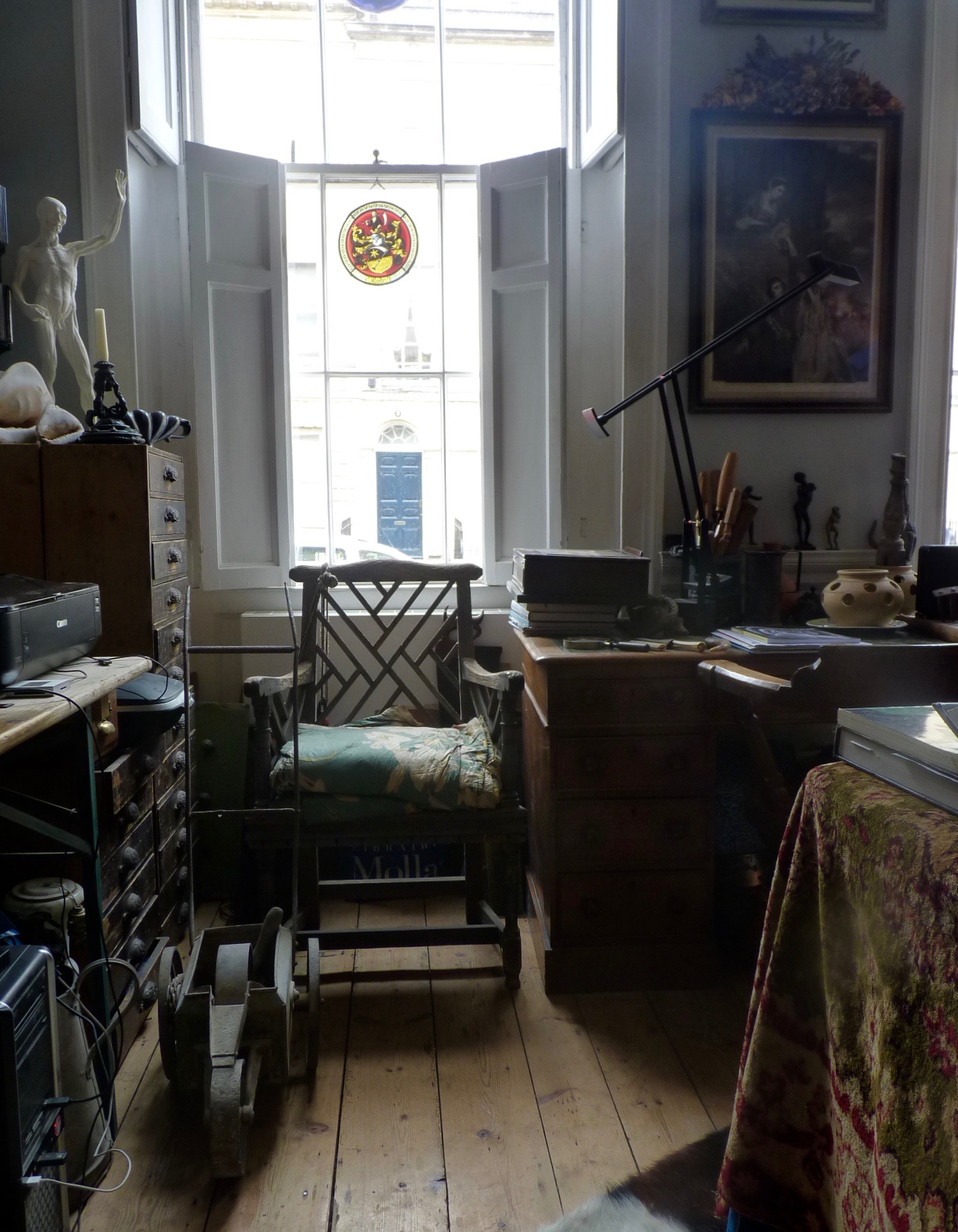
One of those old fashioned push-along machines for marking out white lines on a grass tennis court. I used one of these as a child to mark to paint white lines onto the lawn in the garden at home but my badminton game remains sub-average.
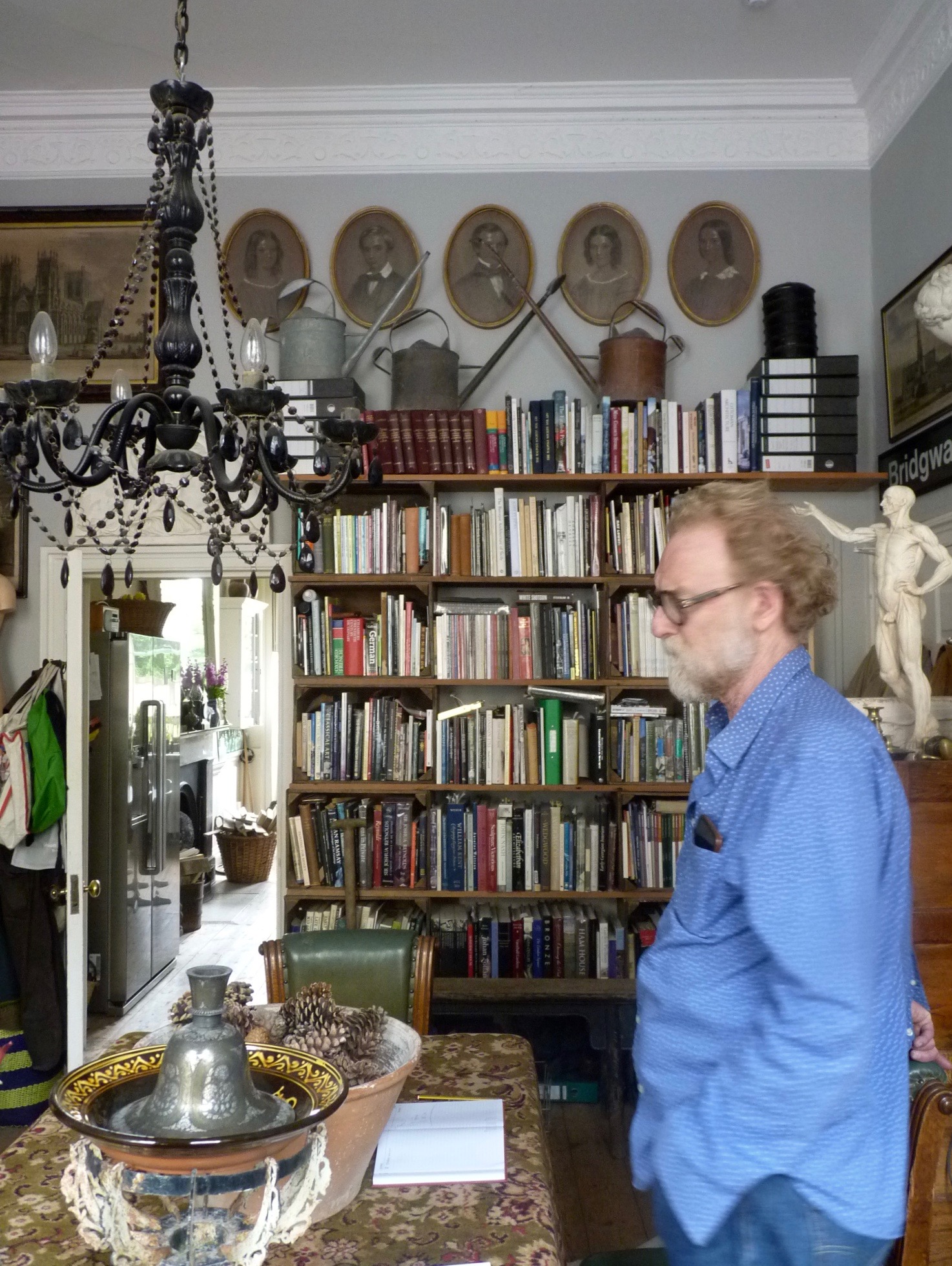
écorché figure, top right, modeled for artists, showing the muscles of the body as if revealed under the skin.
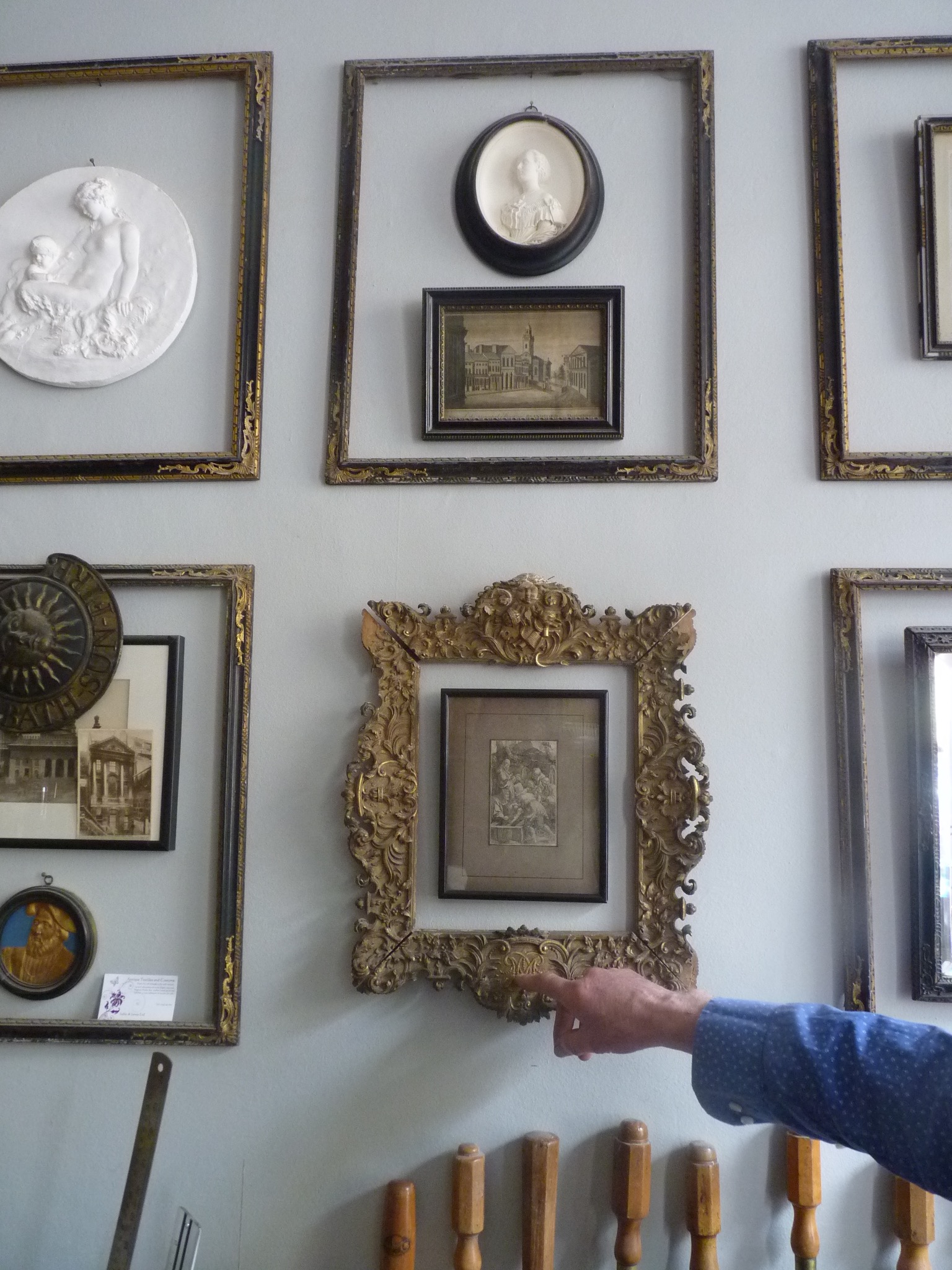
very high quality frame of uncertain date or origin
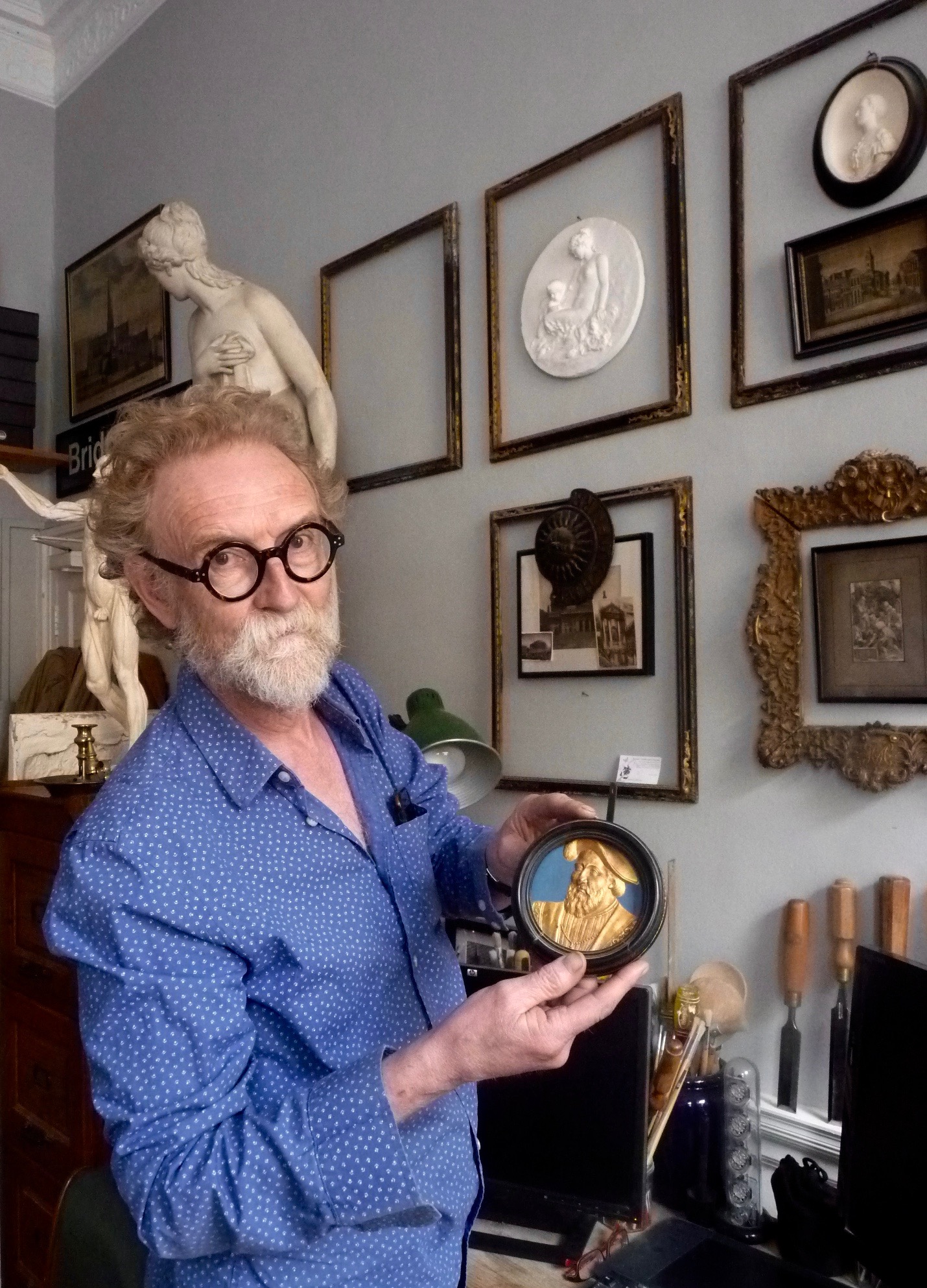
And a small but very fine Renaissance-era portrait tondo
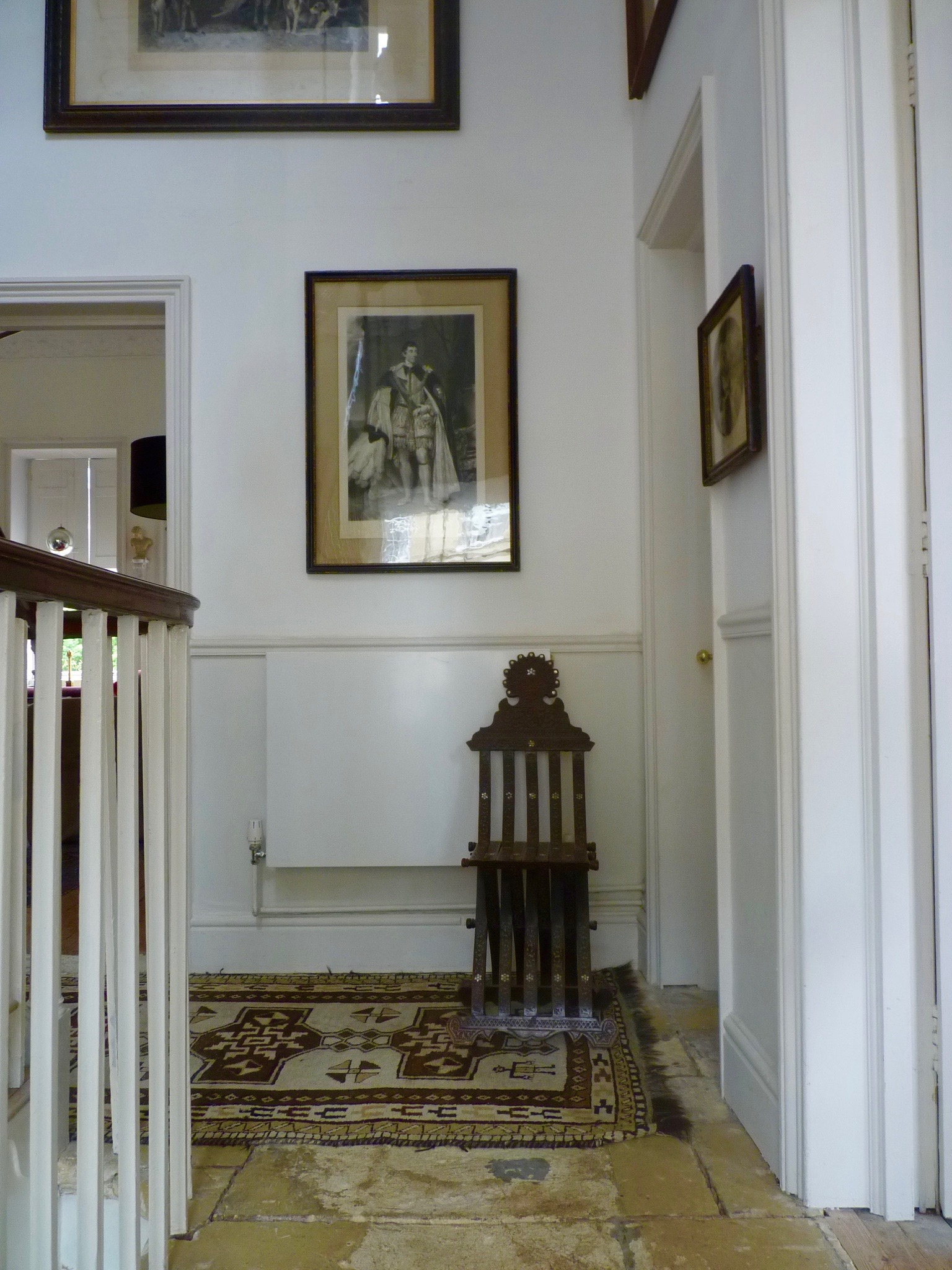
One of my favourite things, Damascus-style folding chair, one of a very beautiful pair.
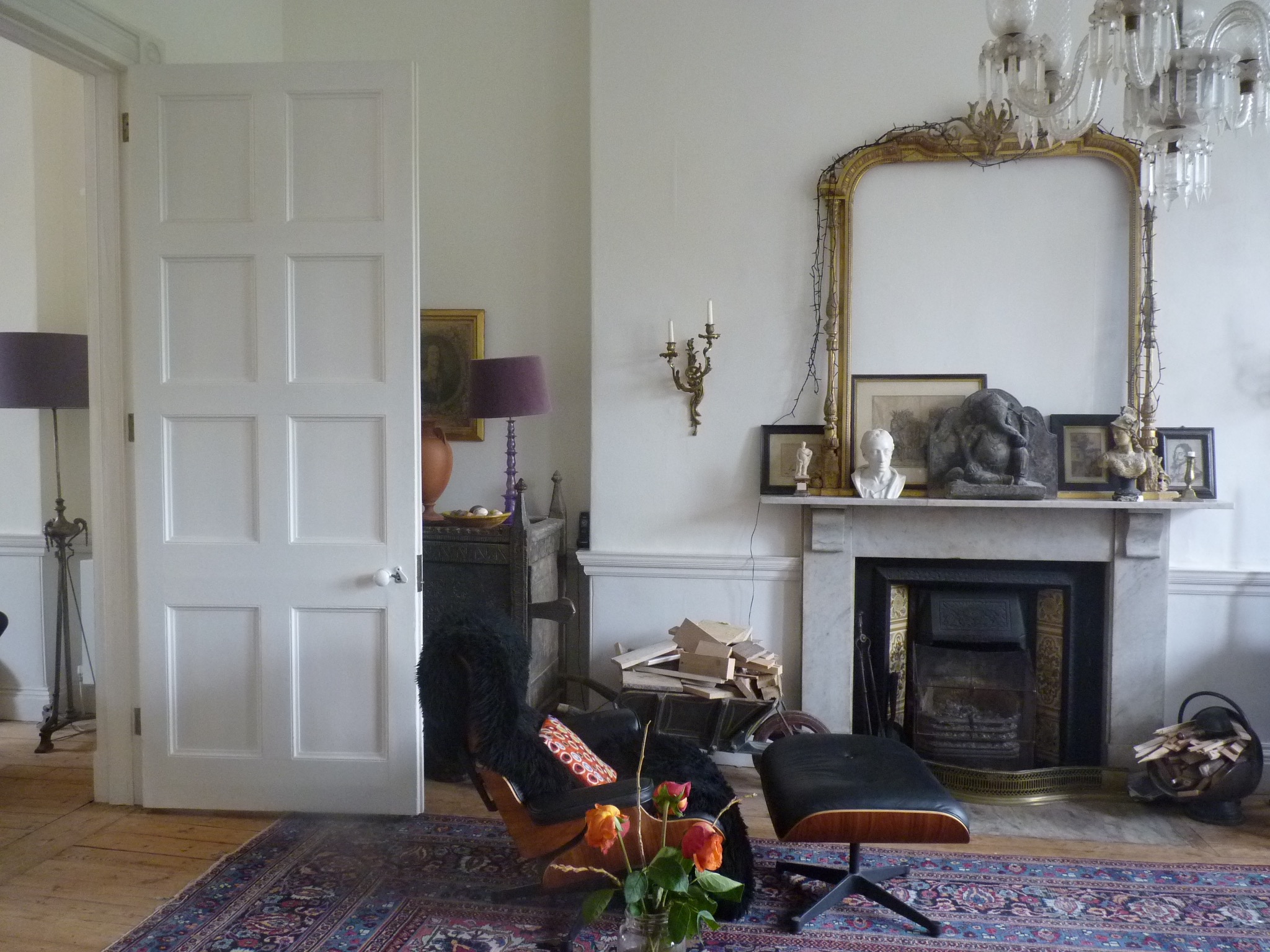
The first floor drawing room.”All the paint is from a company called Johnsons, they will copy any colour you like.’
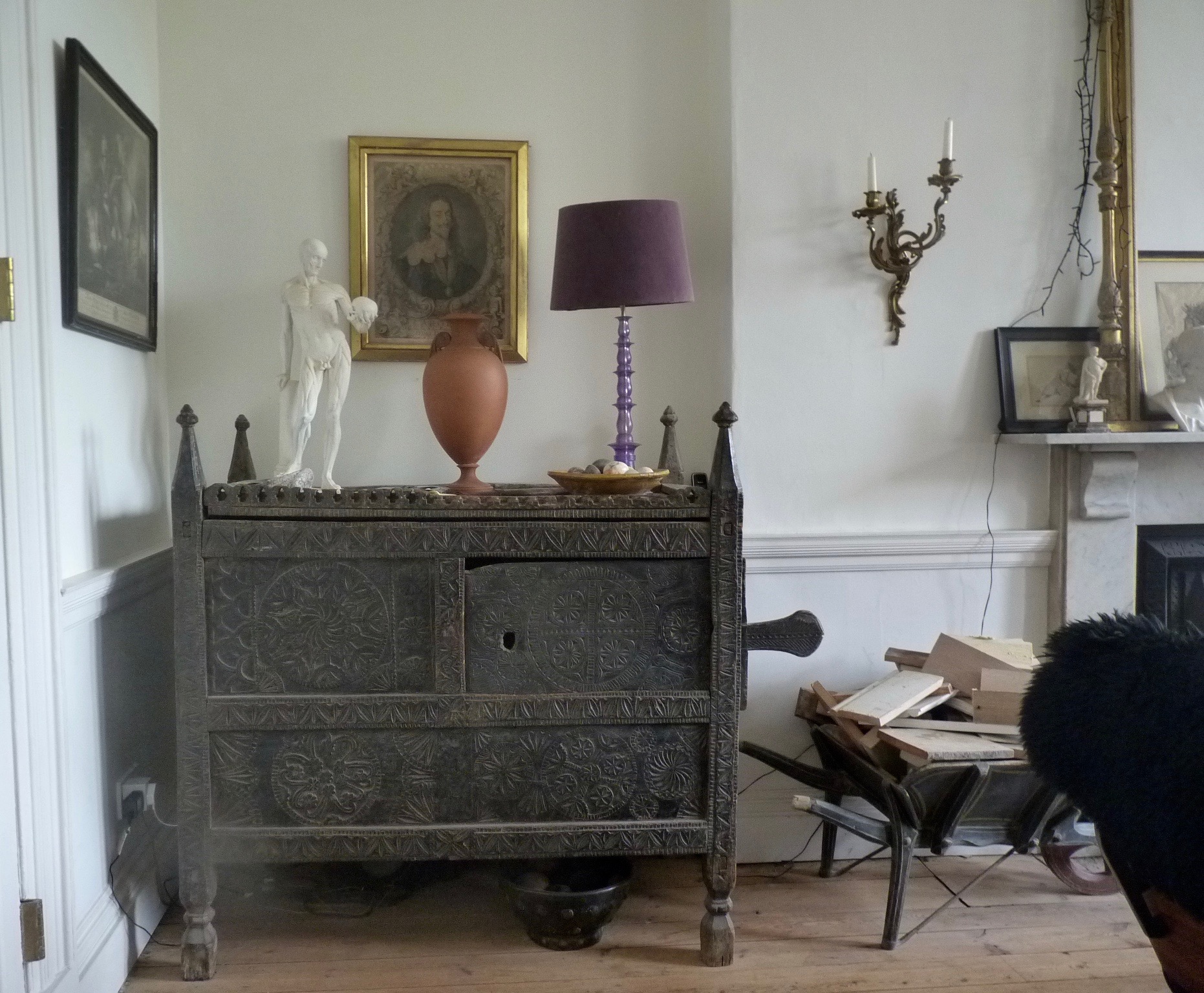
Indian dowry coffer
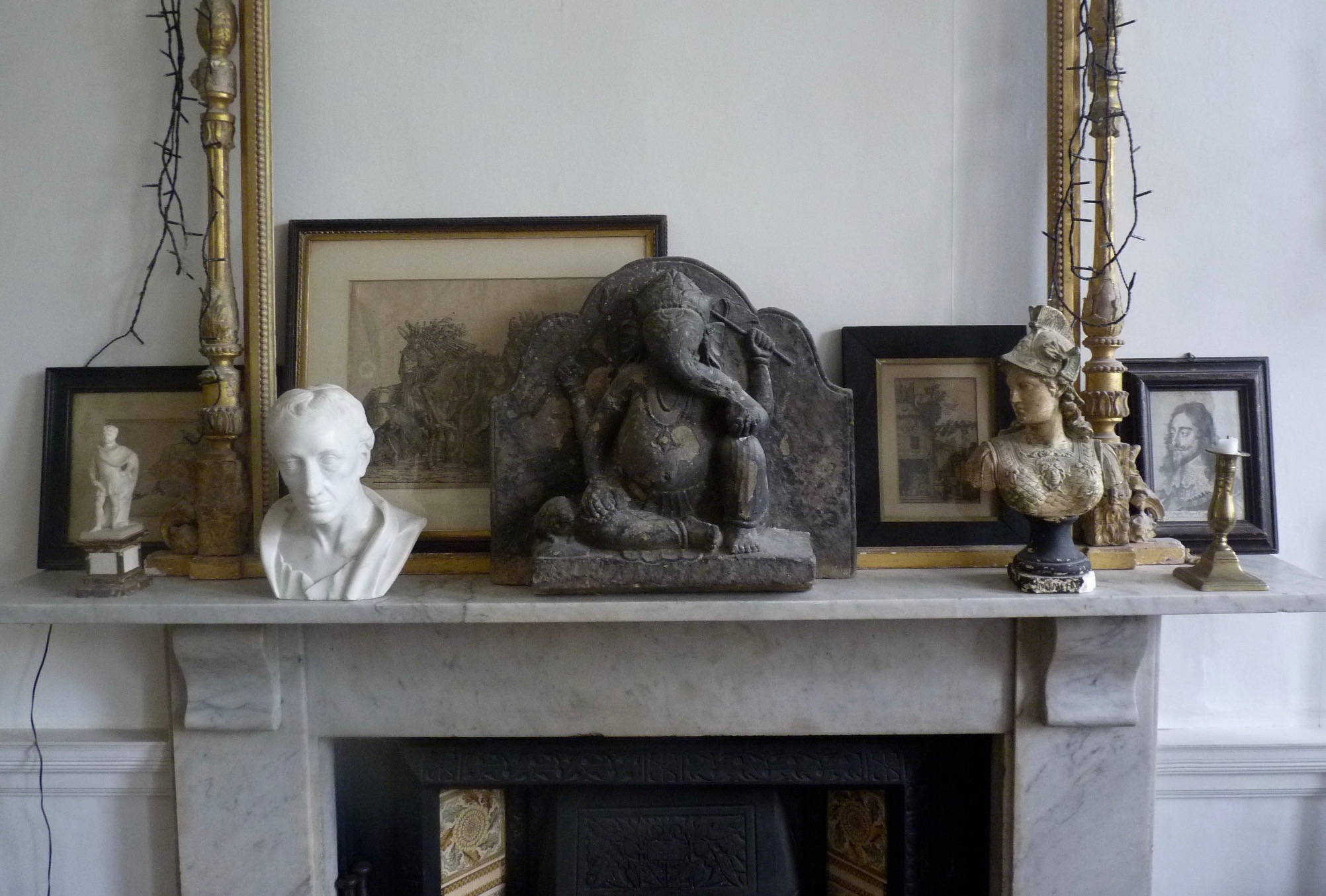
Household gods. A marble statuette of our first Hanoverian monarch, King George I, small marble bust (sans socle) of Alexander Pope, Ganesha the lucky Elephant god and a bust of Athena. ‘ I bought my first bust of Pope back in 2000. I went to the V and A they said, Oh its C19th, there’s hundreds of them. I found an engraving of it from 1788, it couldn’t have been any other bust. It was by Roubilliac.’
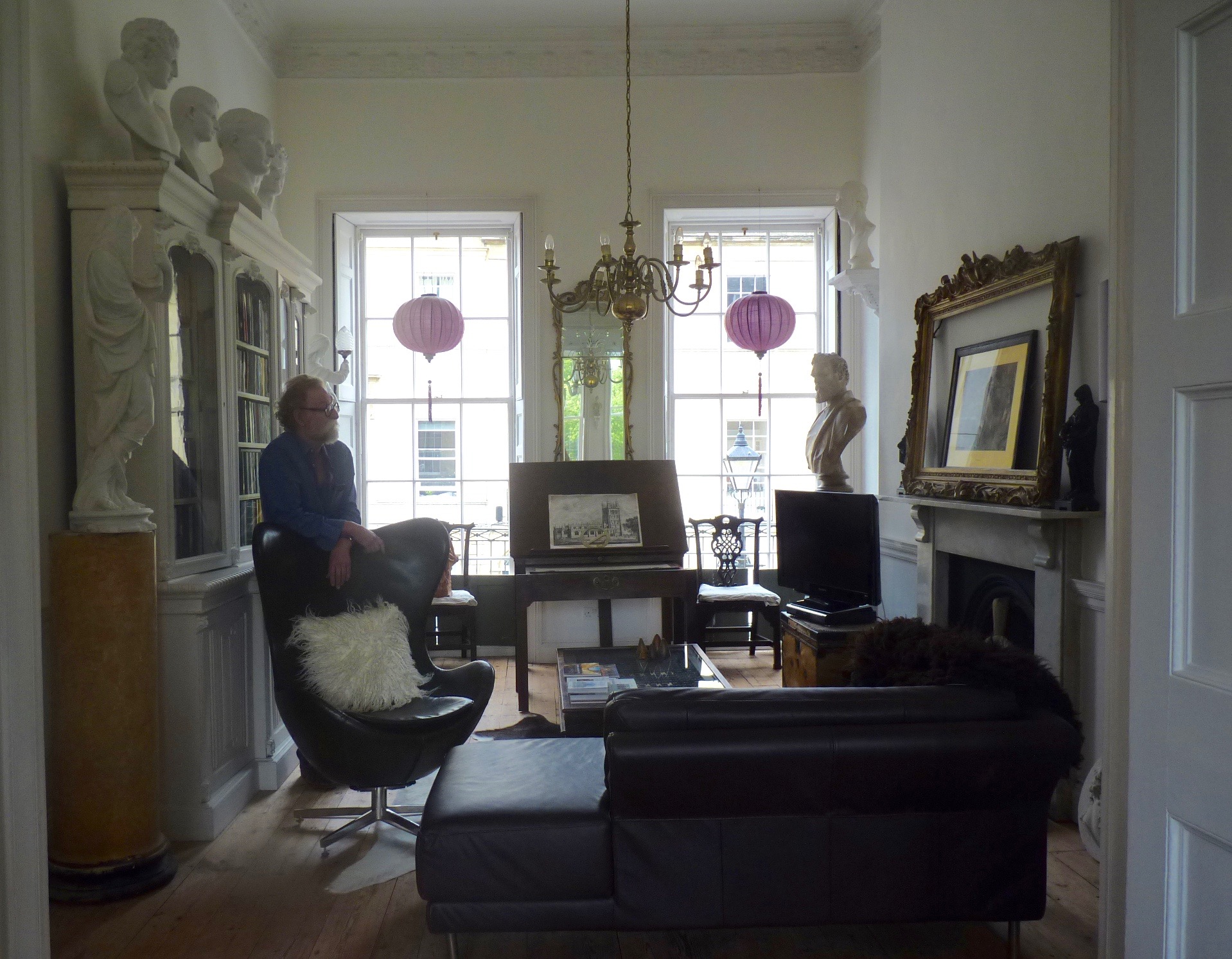
.
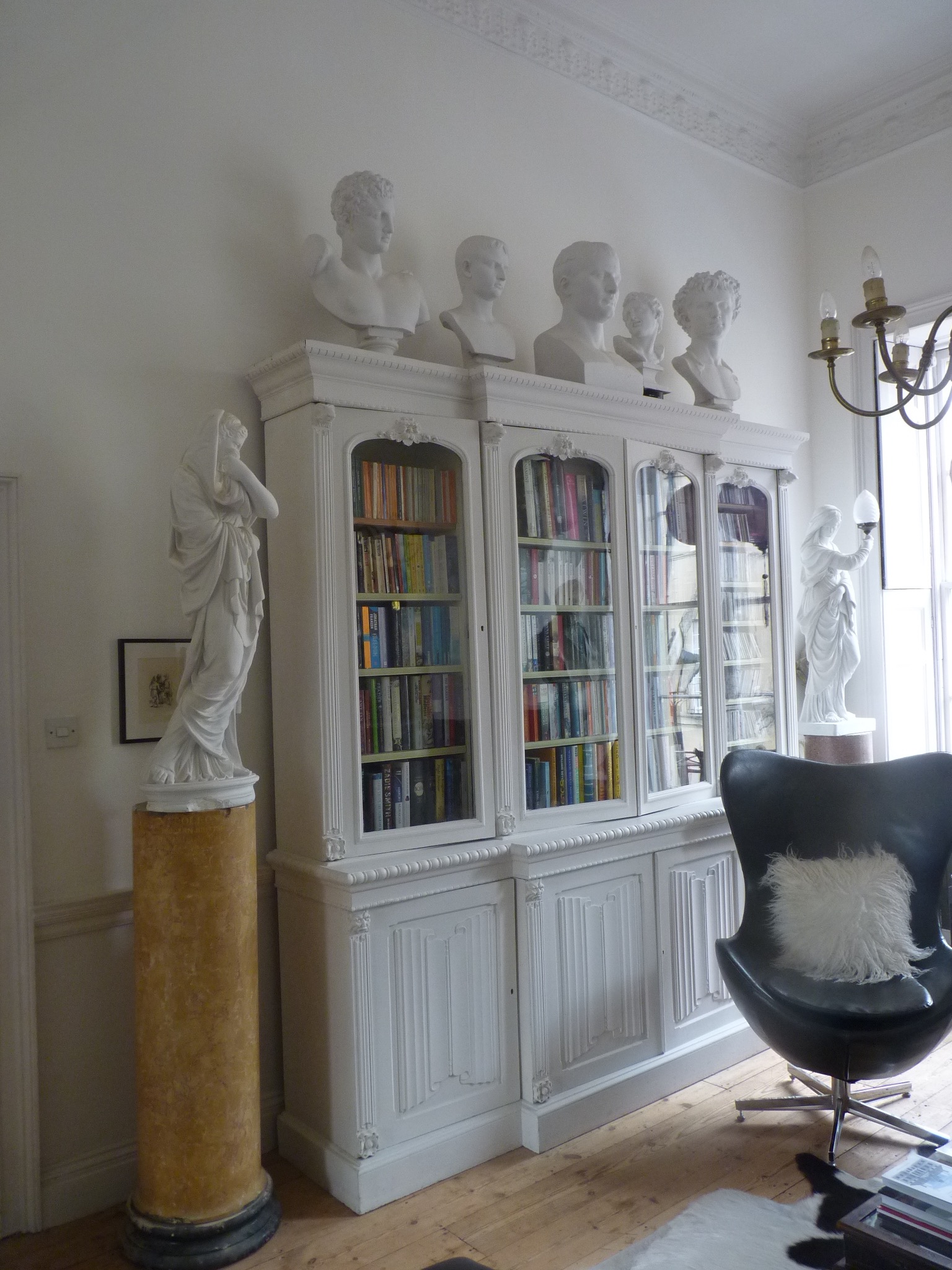
More busts, Napoleon in the middle.
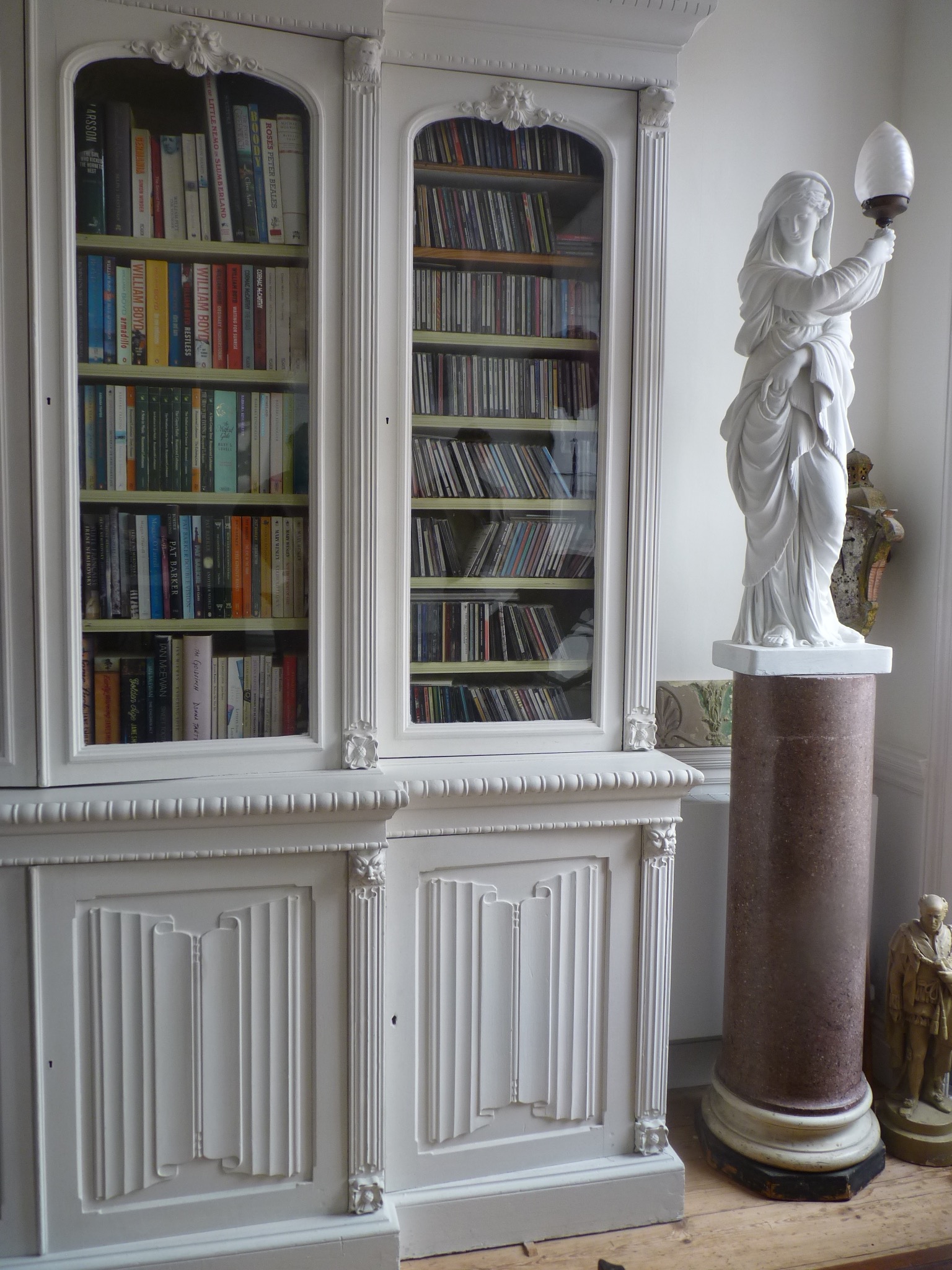
Torchere.
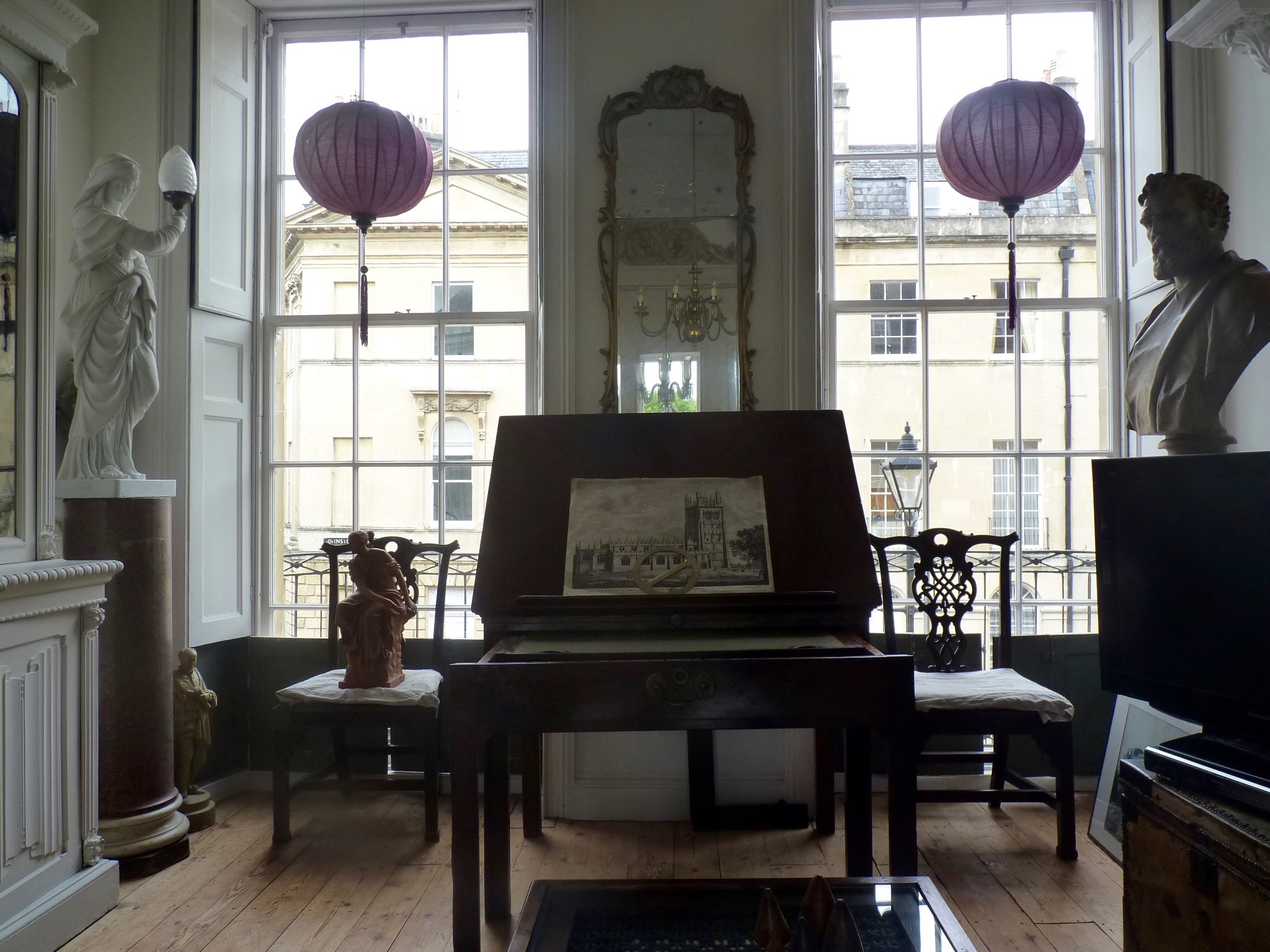
‘An architect’s stand up desk from around about 1760. My favourite thing, found in a warehouse in Newark, it had been there for quite a long time.’
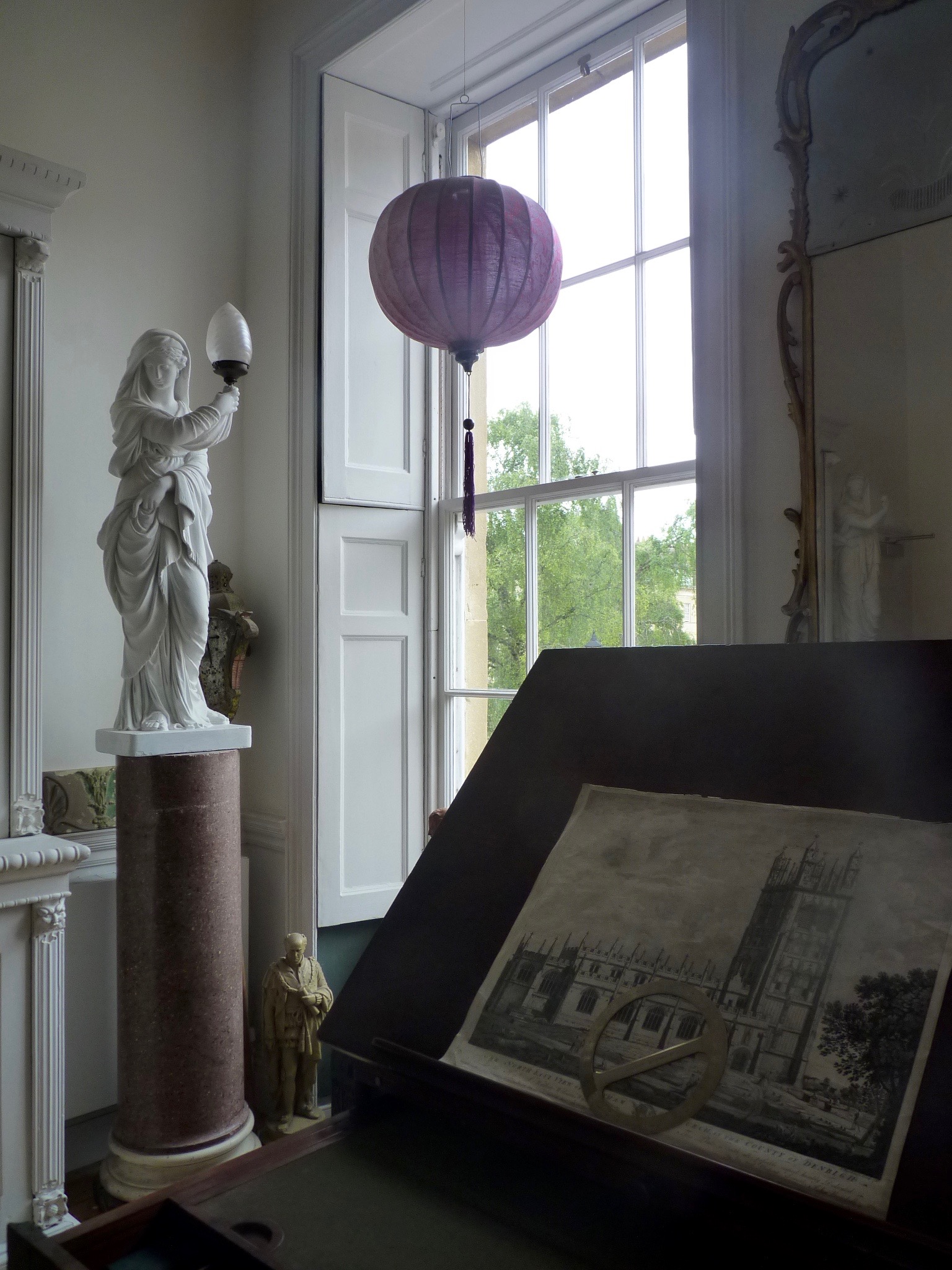
‘It’s a very ingenious thing, beautifully made, a two-man desk, the top tilts. Hidden drawers pull out.’
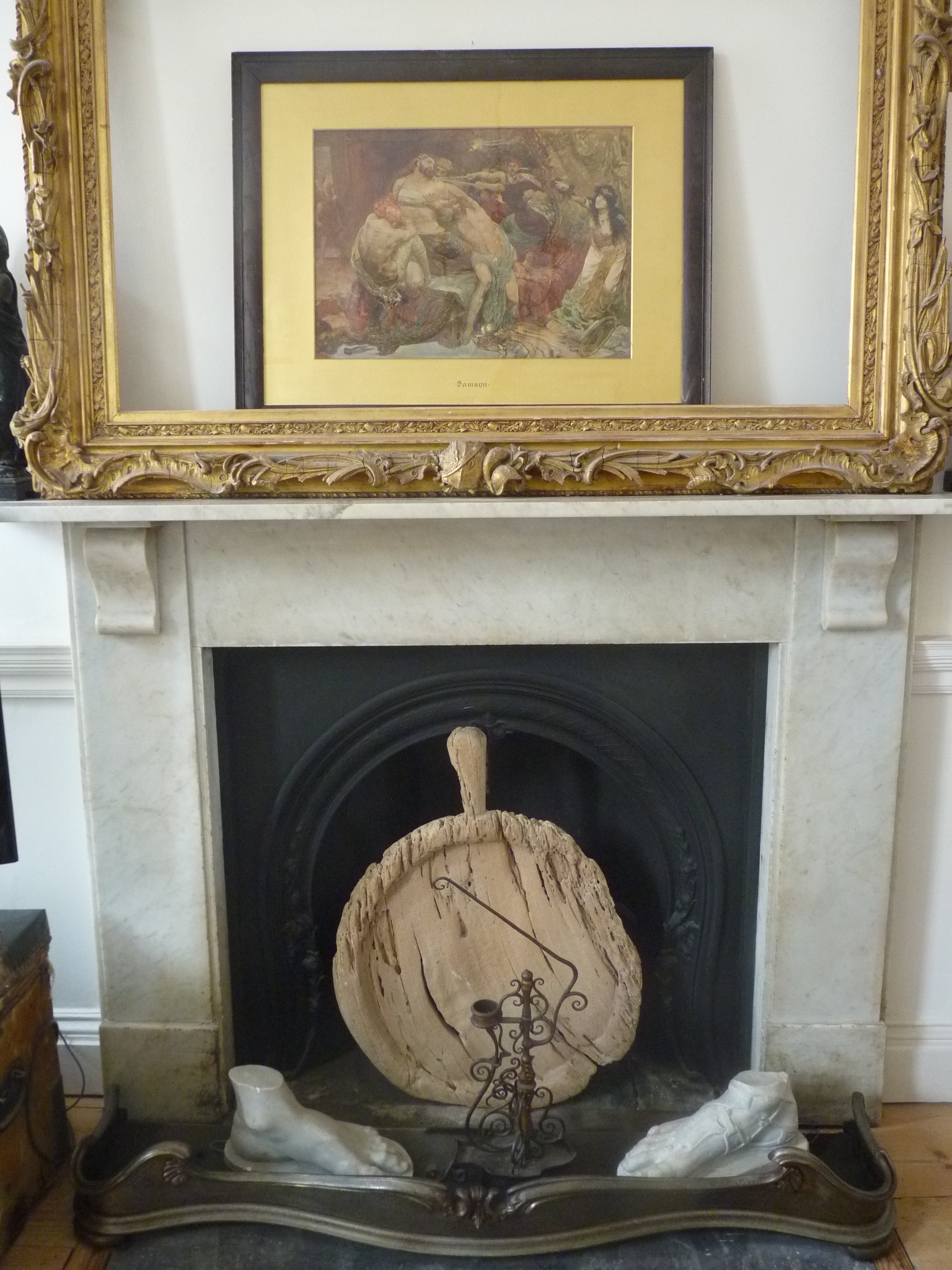
.
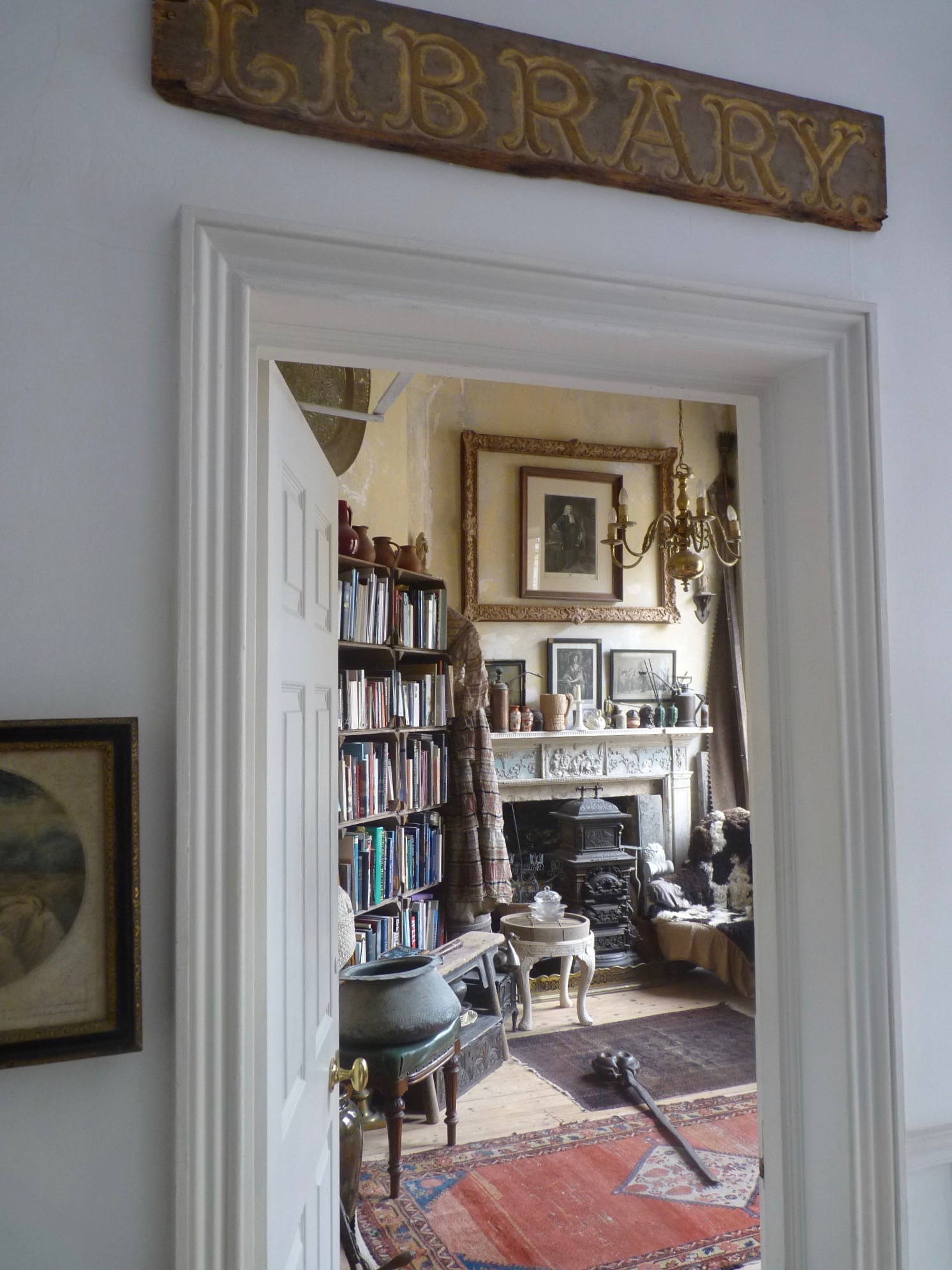
Around the corner, the very best room of all, a genuine cabinet of curiosities ( that over-used term).
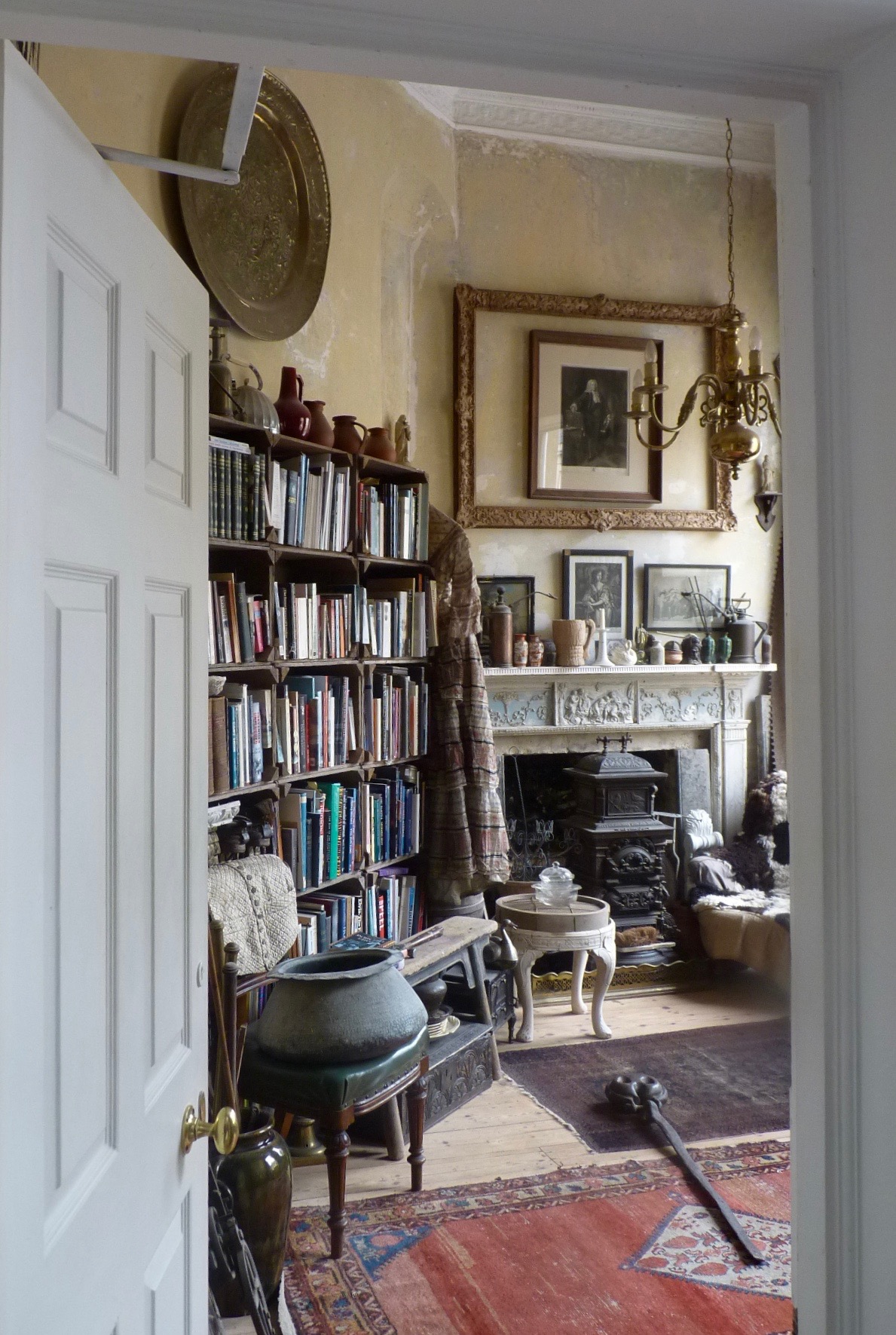
The walls are unrestored with bare plasterwork in places. The object on the floor is an ancient, lethal. two-man hedge trimmer.
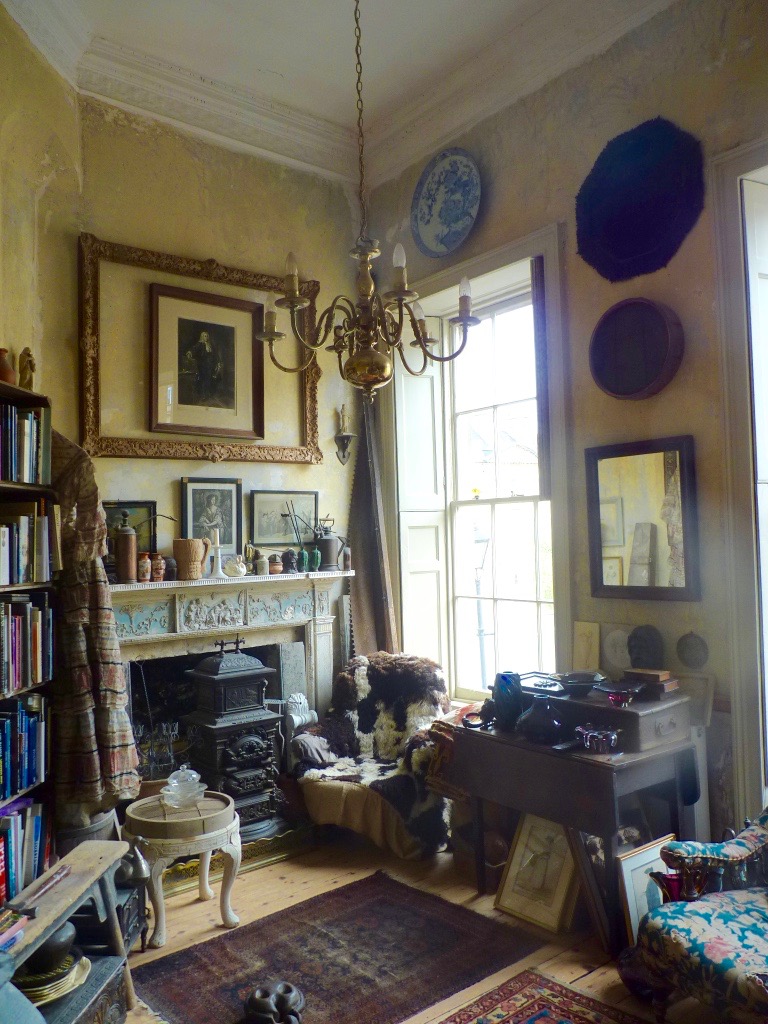
Back in the 70s I used to go to France and fill a lorry – bring stoves back, and I’ve got one or two souvenirs left from that time.’
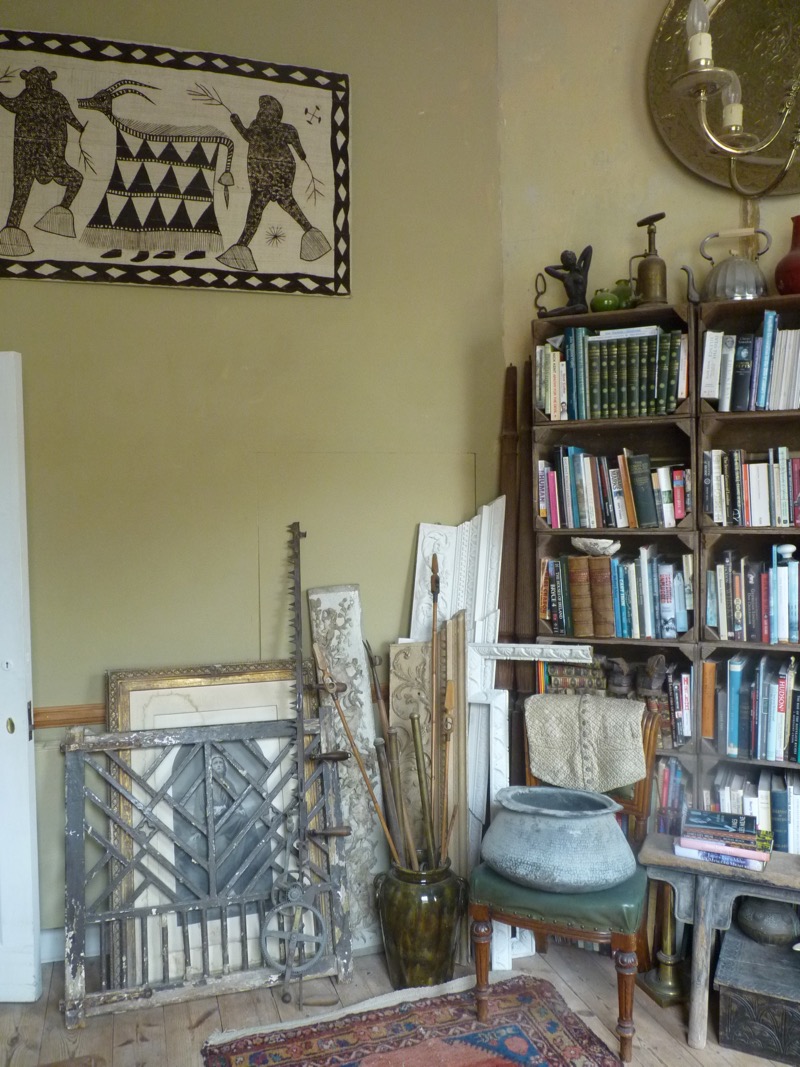
The textile wall hanging is Nigerian, it was £3, I found it in a car boot sale. They look like aliens! I’m going to put it in that frame, it’s French C17th, I like that dynamic, to put a bit of Africa in it’
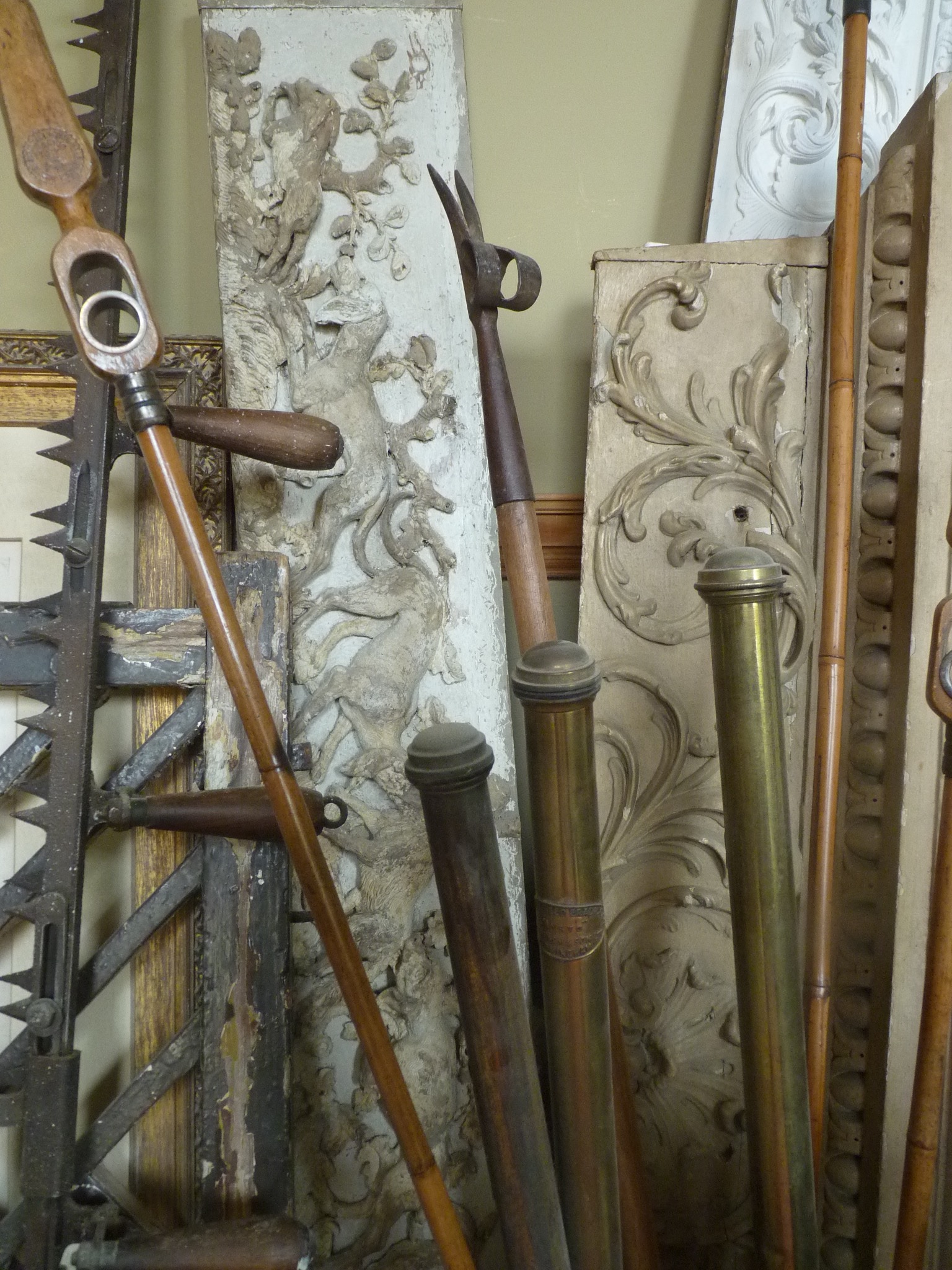
This cross-piece from an overmantle is decorated in papier mache with a scene from a hunt, hounds chasing a fox in pursuit of a hare ‘Unfortunately someone had a go at it with paint stripper. I picked the rest of the paint off it but the elegant face of the fox is gone.’
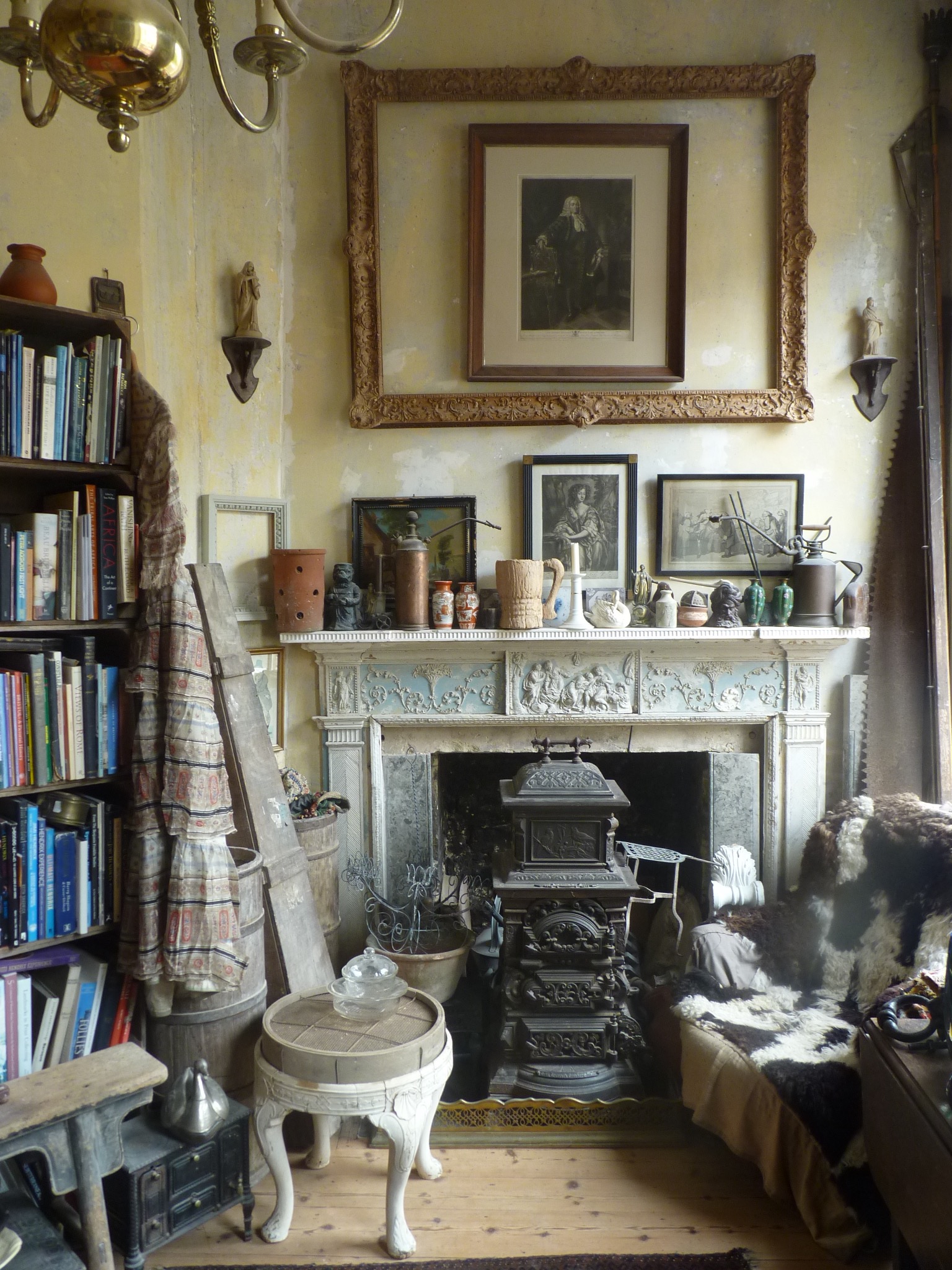
The fire surround is Scottish.
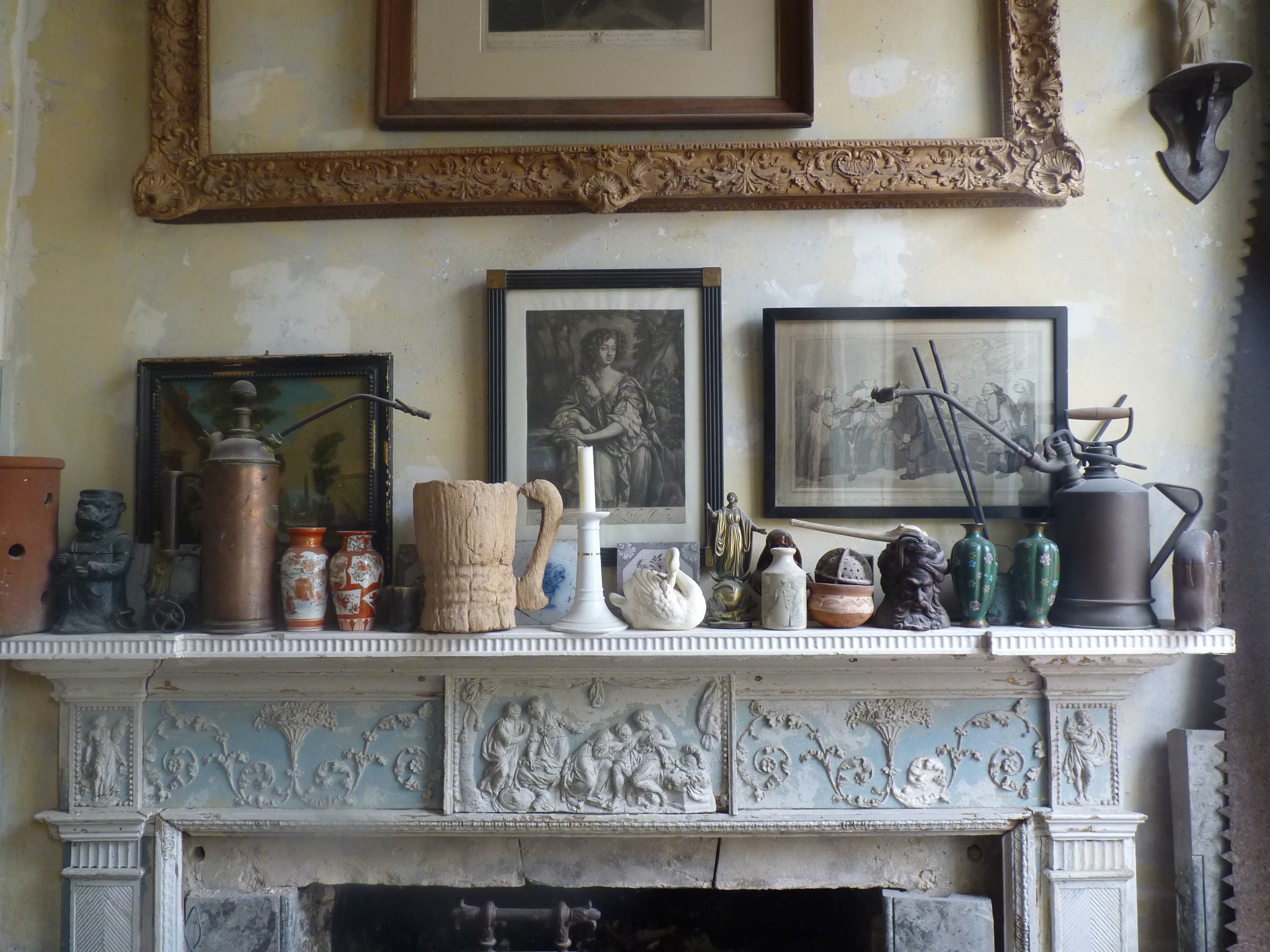
‘I took off the paint – it was so thick with paint – but left a bit here, to show what it was like when I got it.’ The figures at the two ends are Bacchus and Ceres. Perhaps it was made for a Dining Room? The china swan was a wedding present from a friend.
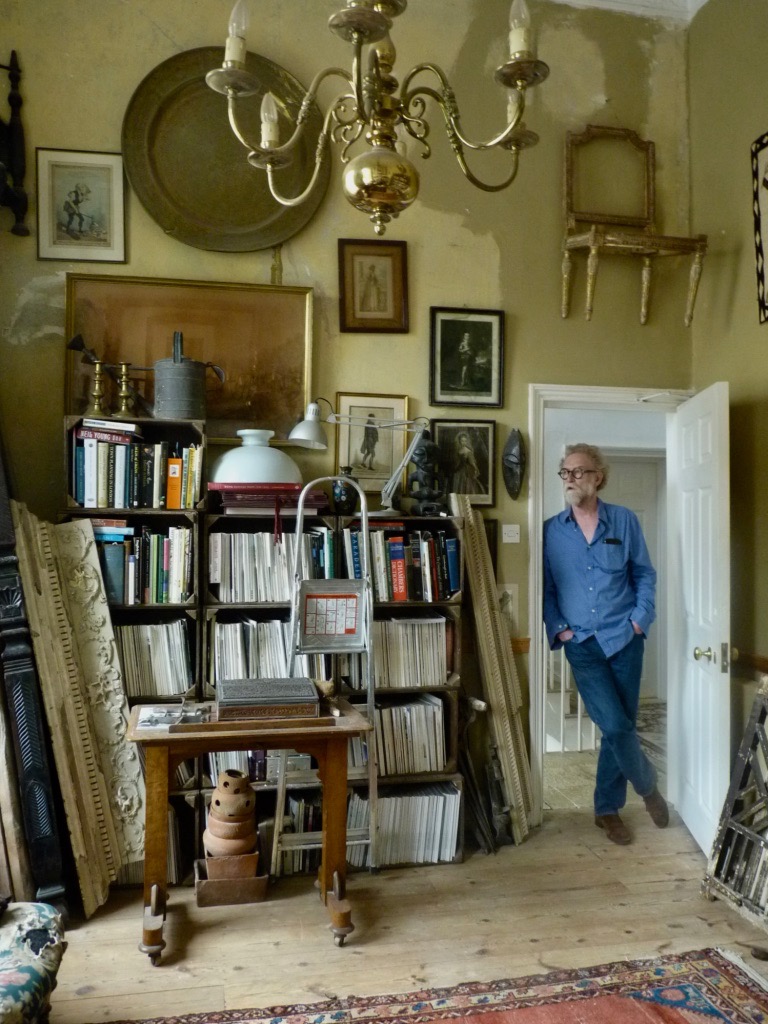
‘The bookcases are made of piled up apple boxes – you could buy crate loads of them at one time.’

.
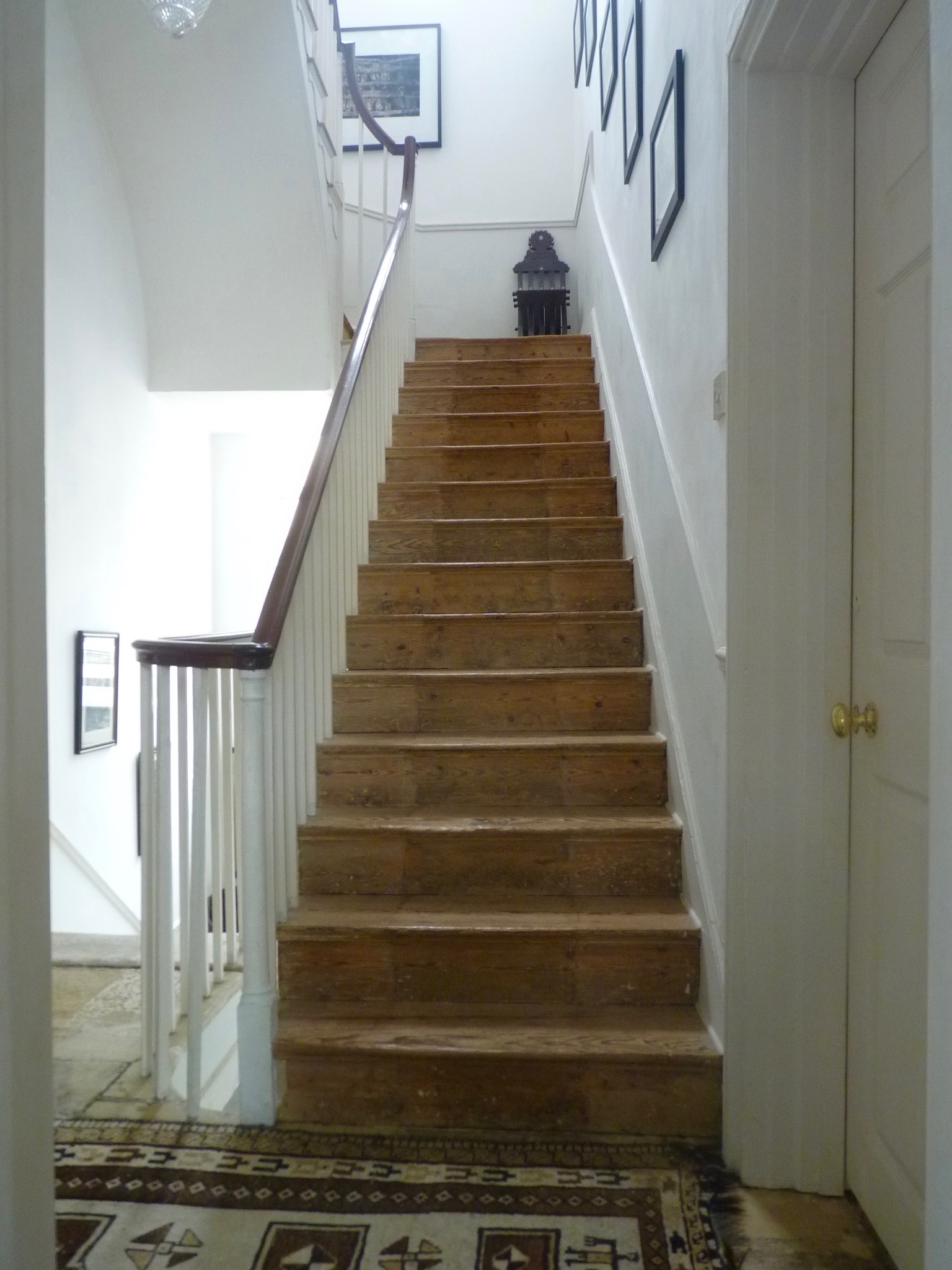
‘The staircase didn’t look like this when we moved here – it was festooned with wires and covered with industrial carpet.’
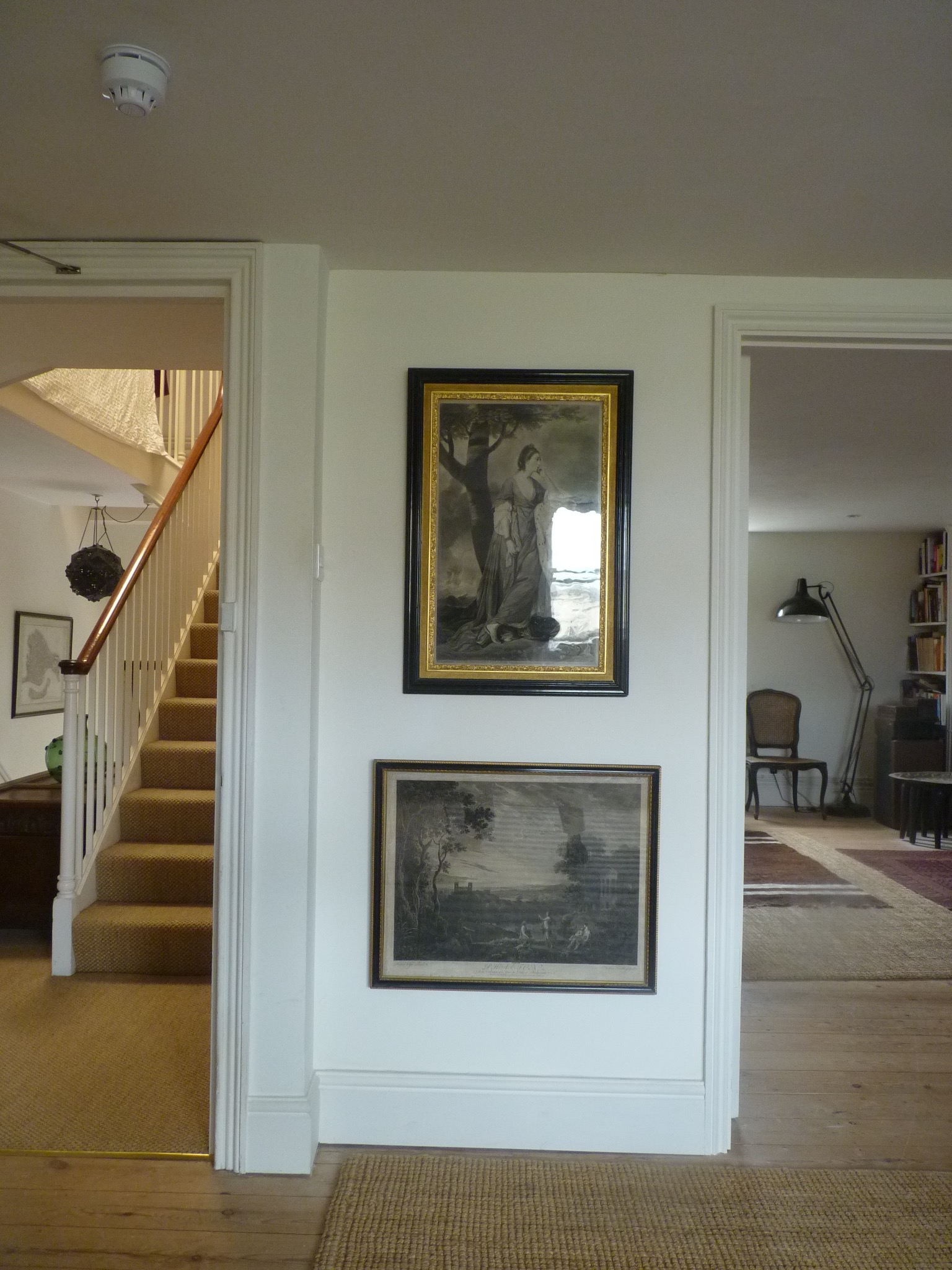
View from the master bedroom to the dressing room
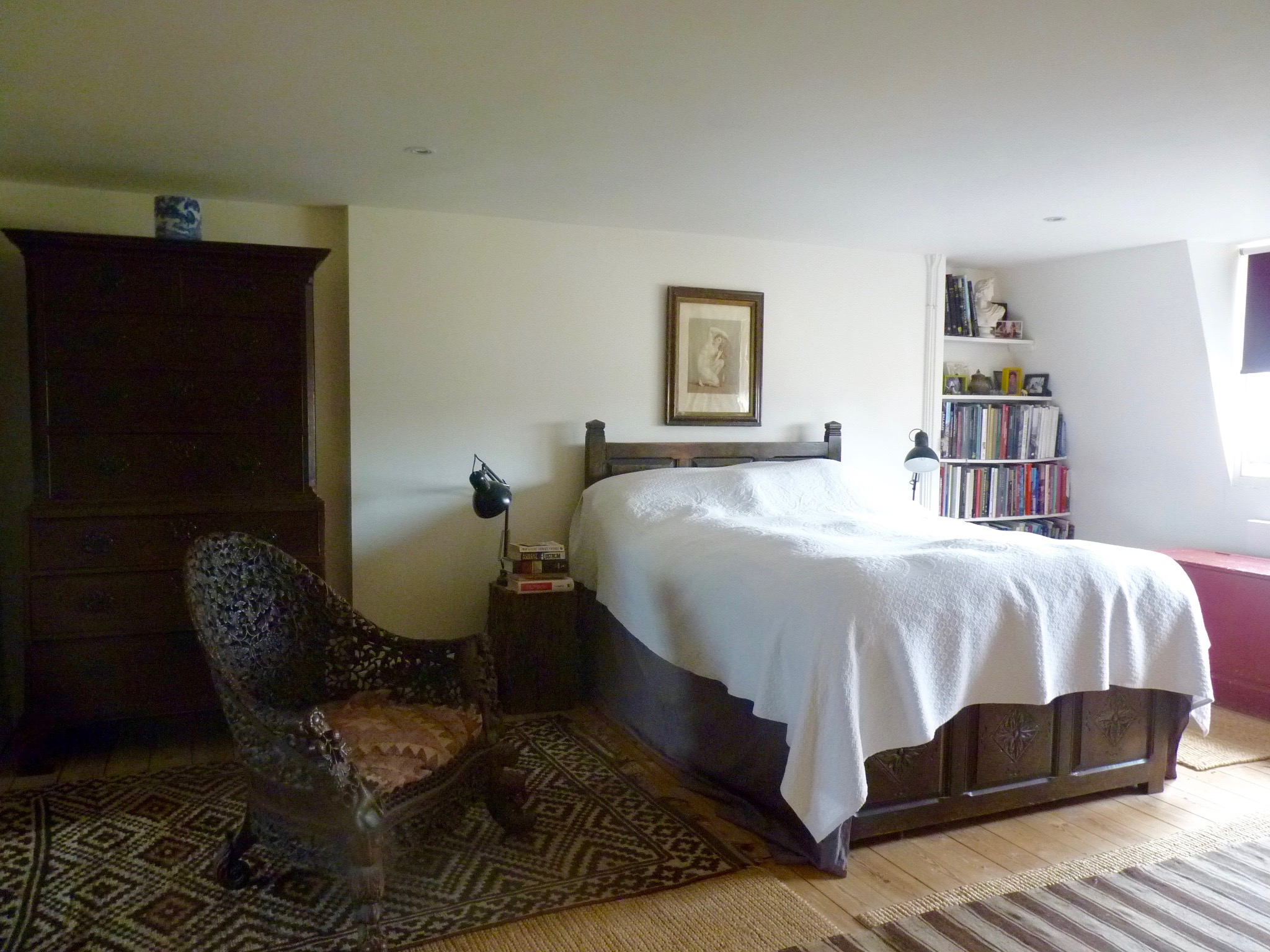
Bedroom with Bombay Blackwood carved chair
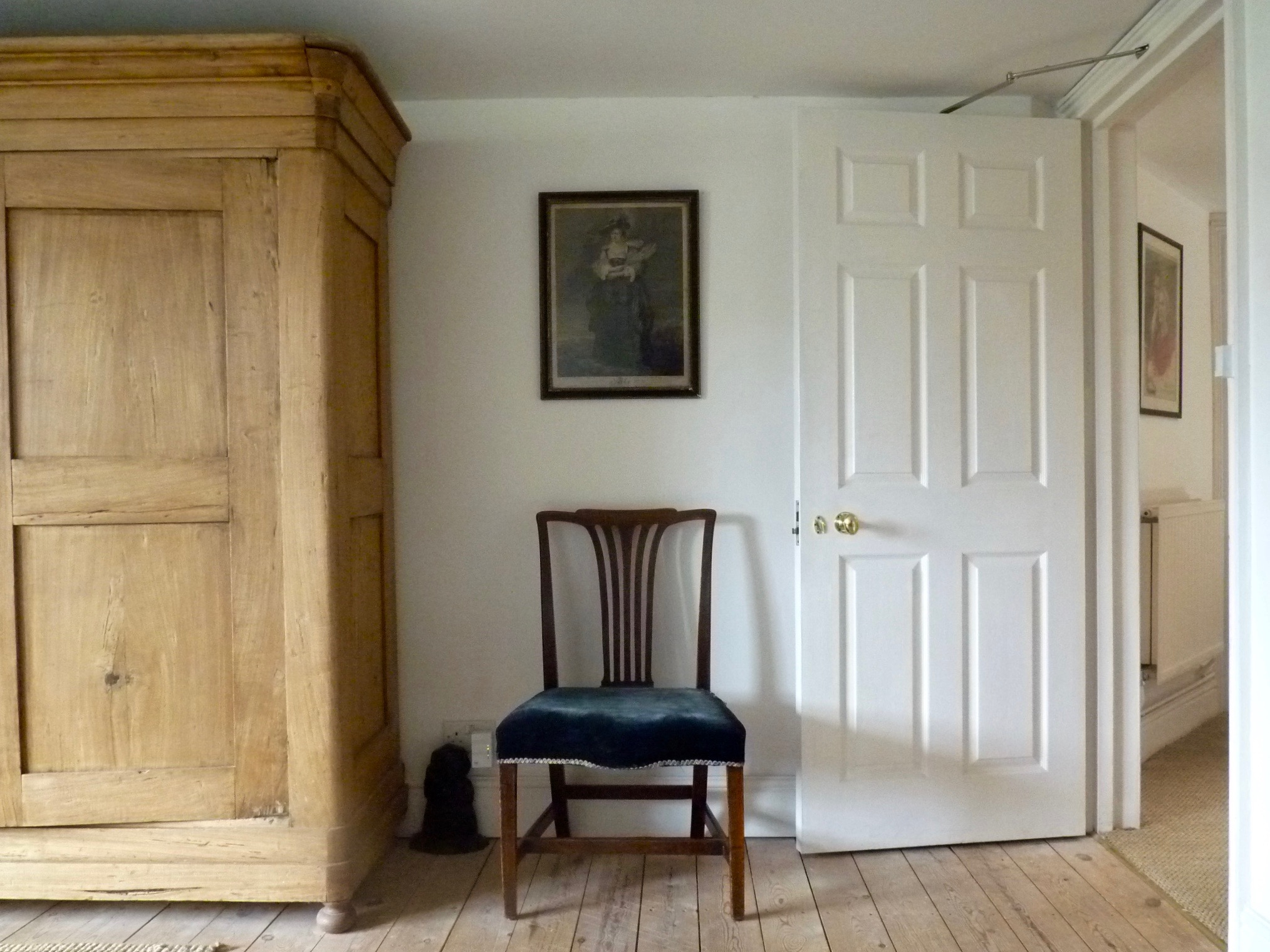
Bedroom
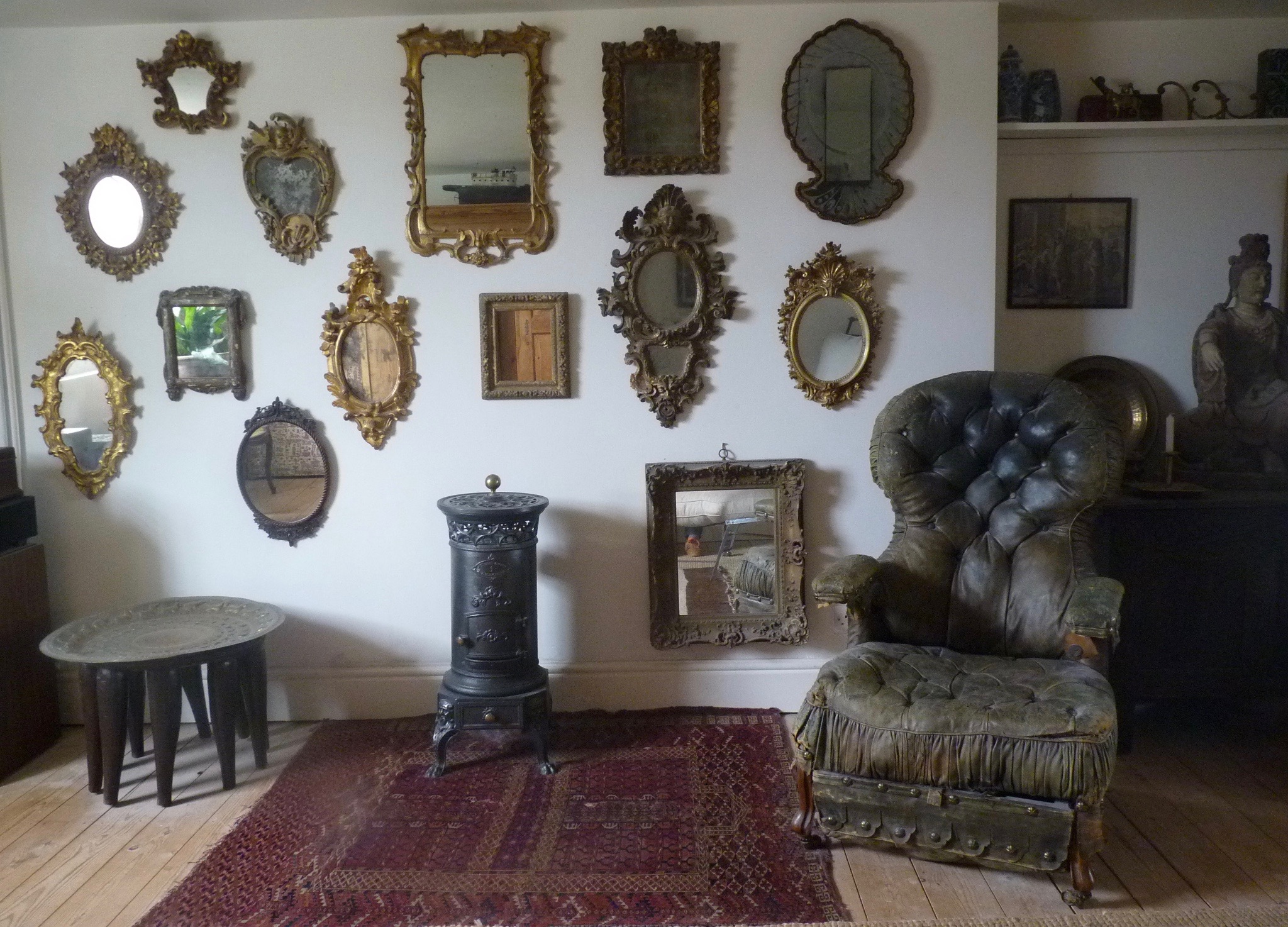
Dressing room. The leather upholstered button back chair is French. Wall of mirrors.
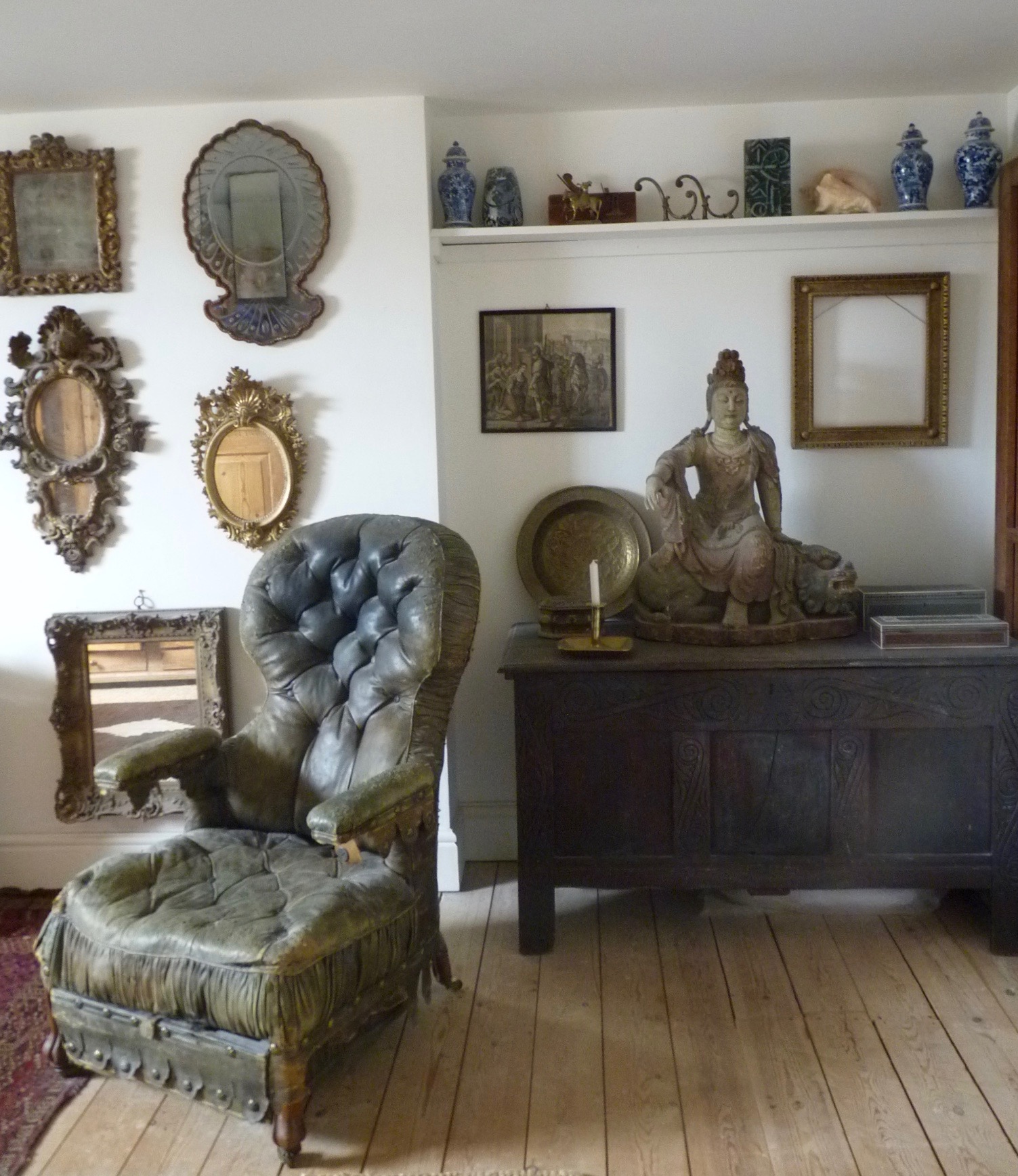
.
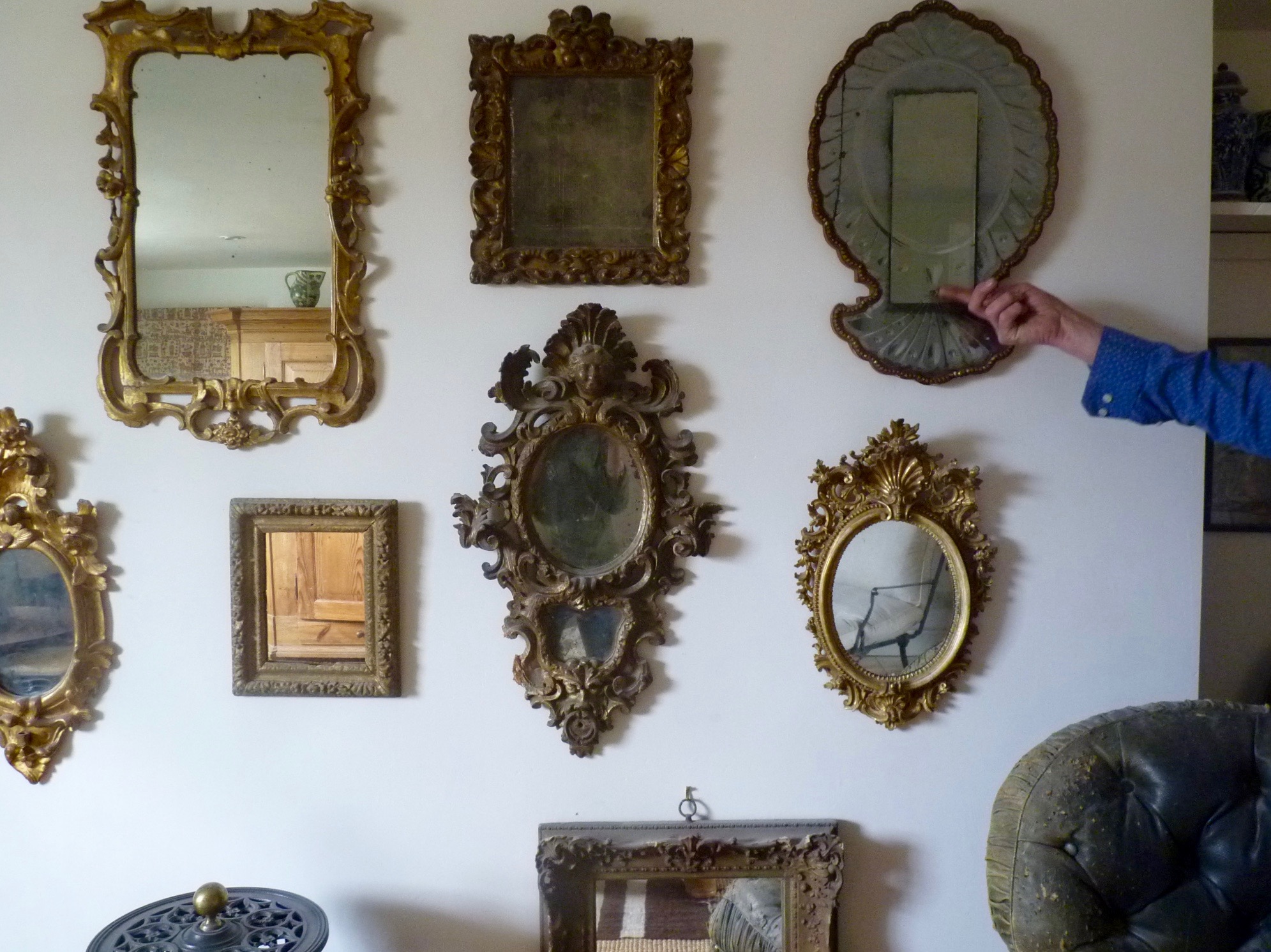
little Venetian looking glass
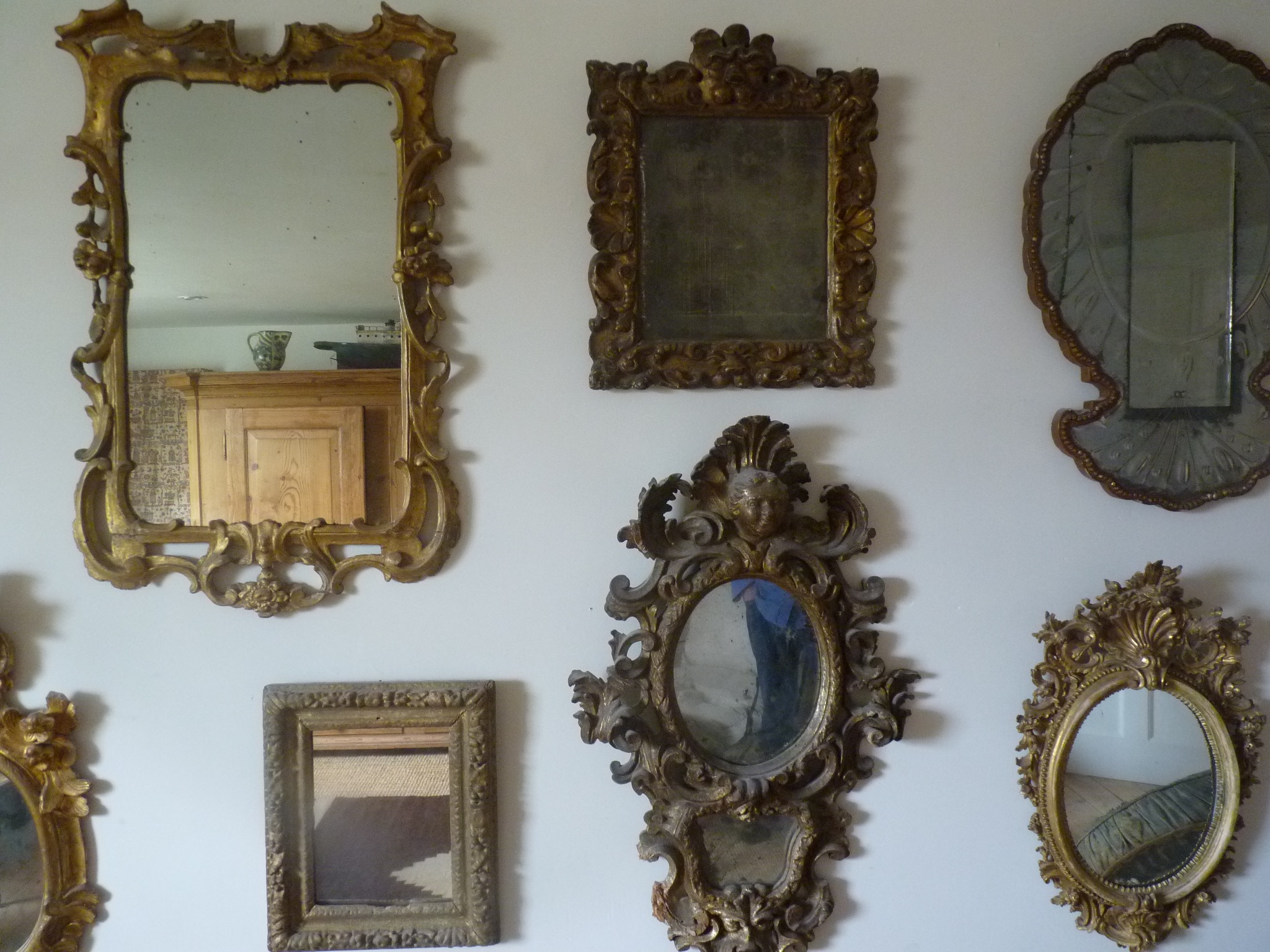
.
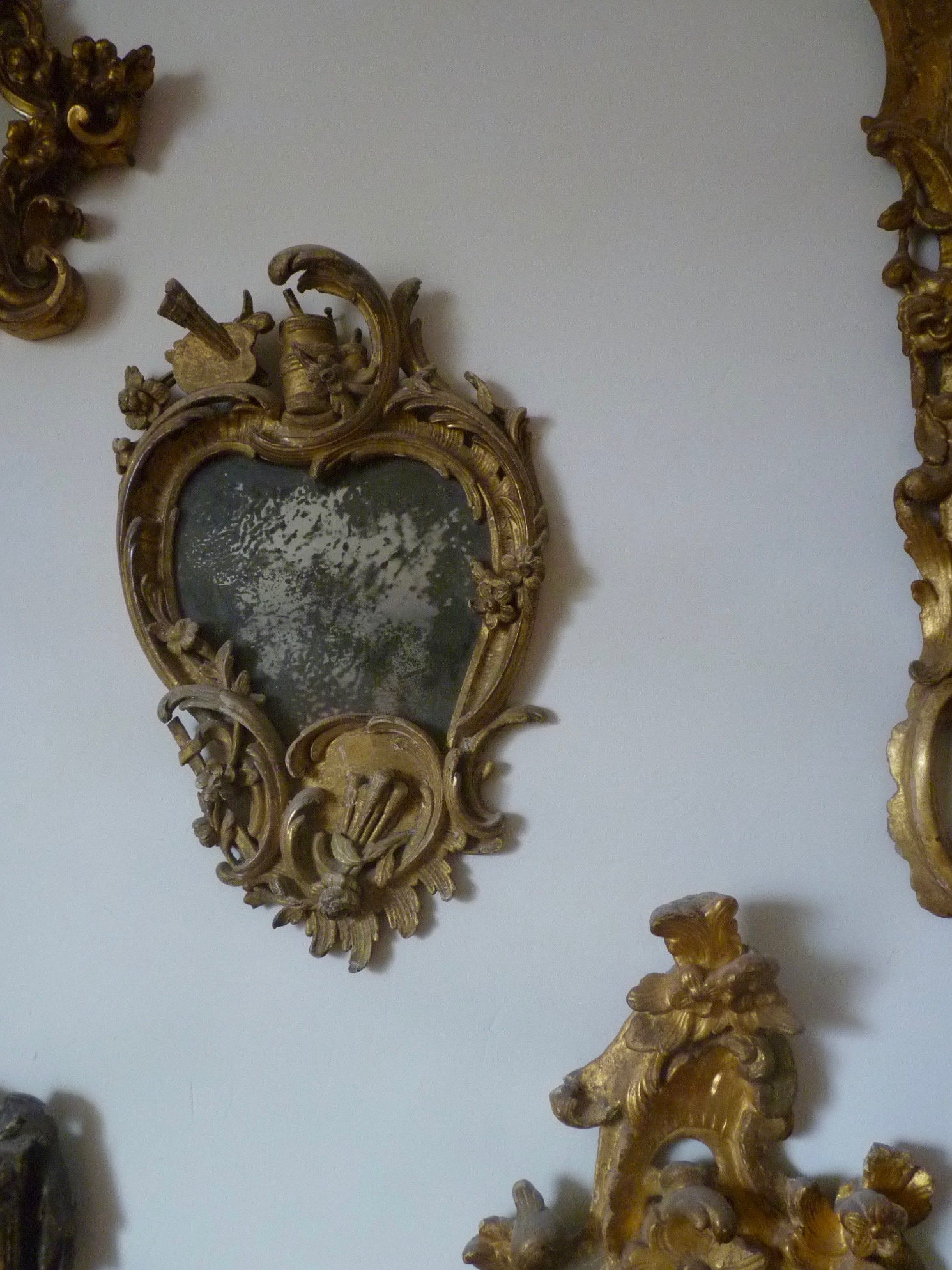
Fabulous ‘artist’s palette’ roccoco looking glass
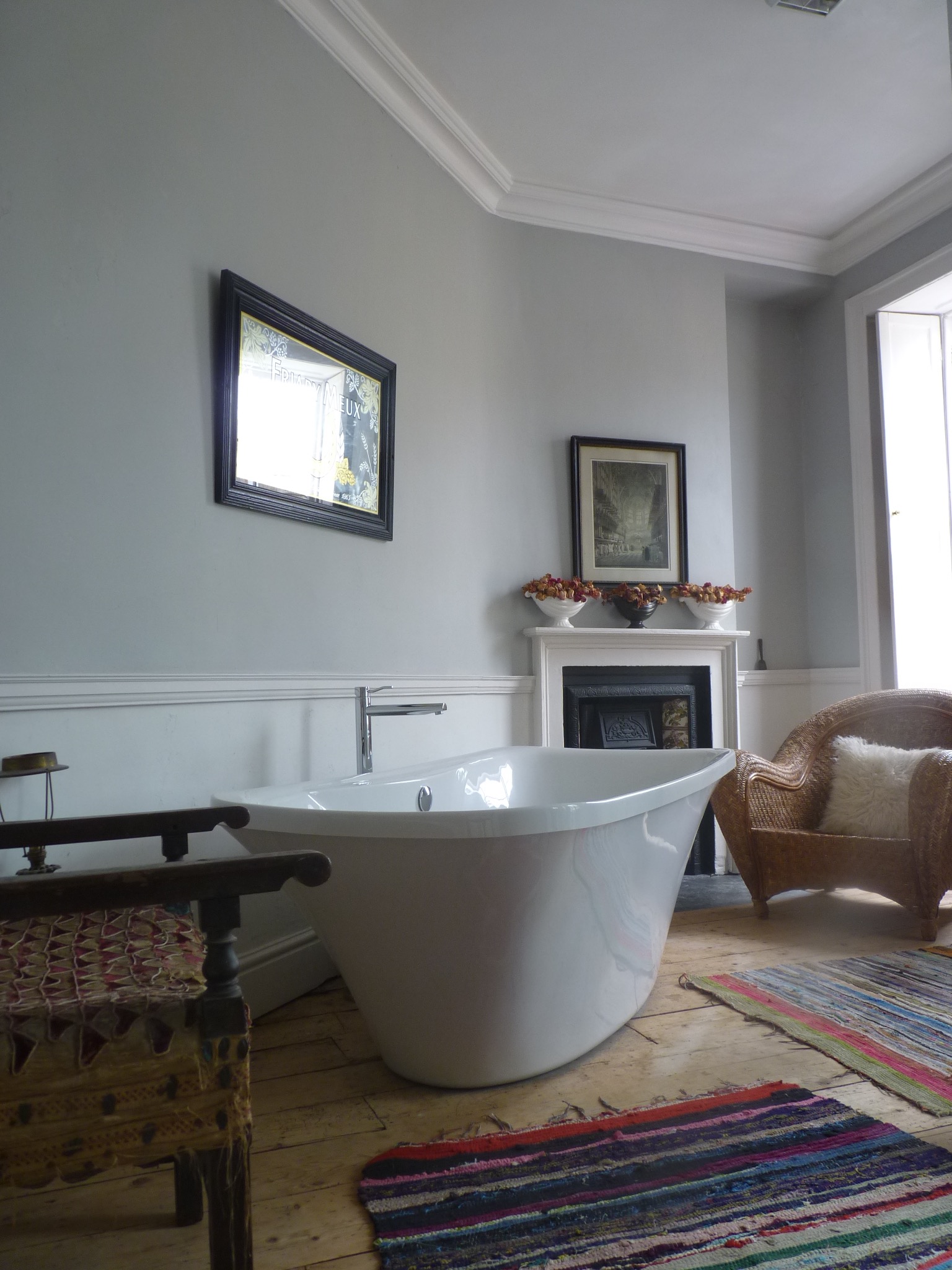
Bathroom
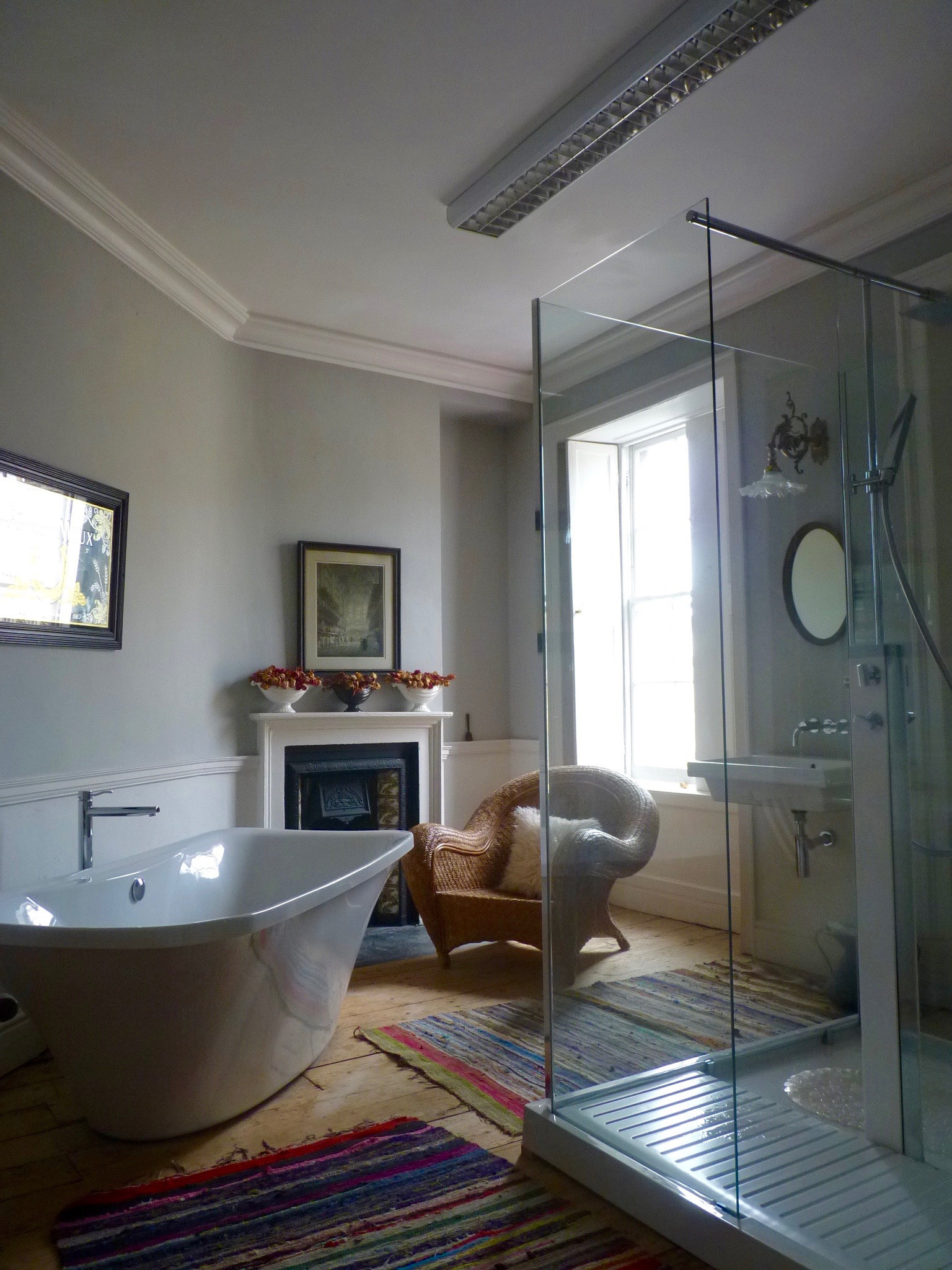
‘This shower – a friend of mine had it for his house and didn’t want it.’
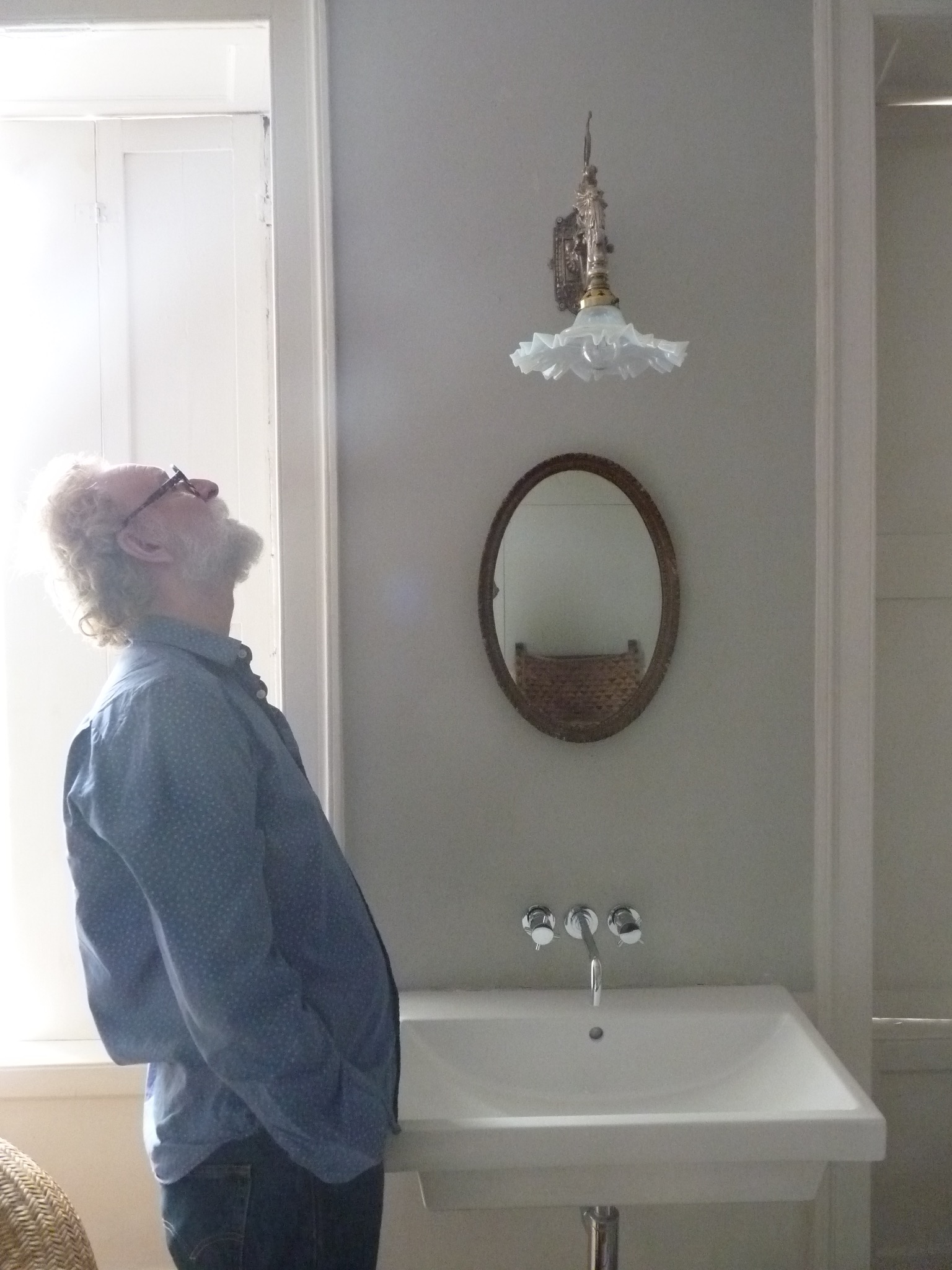
David told me there was something particularly good about this light fitting but I’ve forgotten what, alas
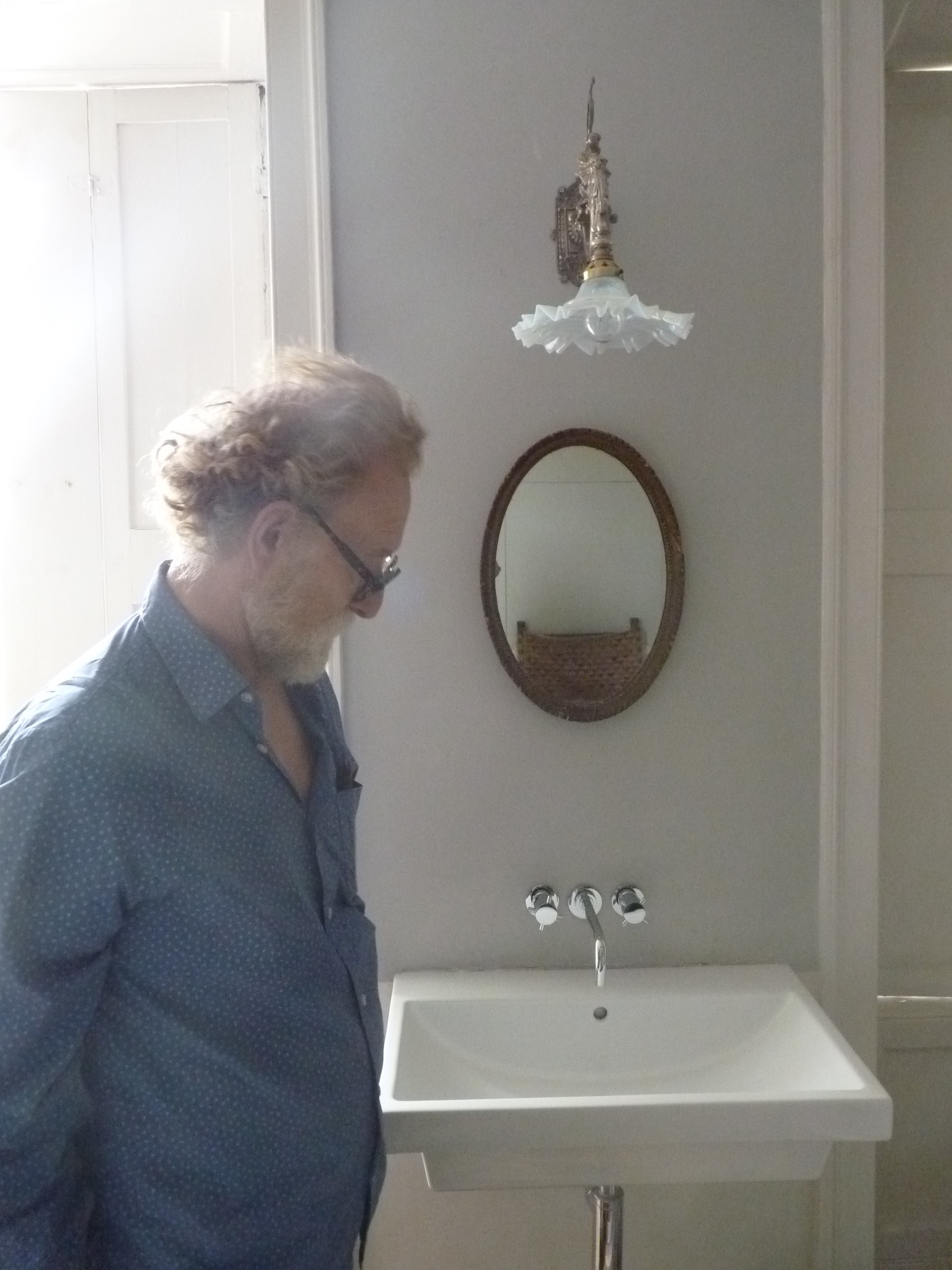
‘Ive always like dealing with dealers,’ David told me. ‘I tried to anticipate fashion. That’s why I got into gardens back in the 80s, that last area of the great house that hadn’t been fully exploited.’ He showed me a koftgari ware box – damacened with a fine pattern of gold inlaid into steel – a very beautiful thing, made to hold a maharaja’s cigars, perhaps. Where did all the good stuff that there used to be – in every junk shop and street market – go? I wondered. ‘I think it all went to America,’ he says.’
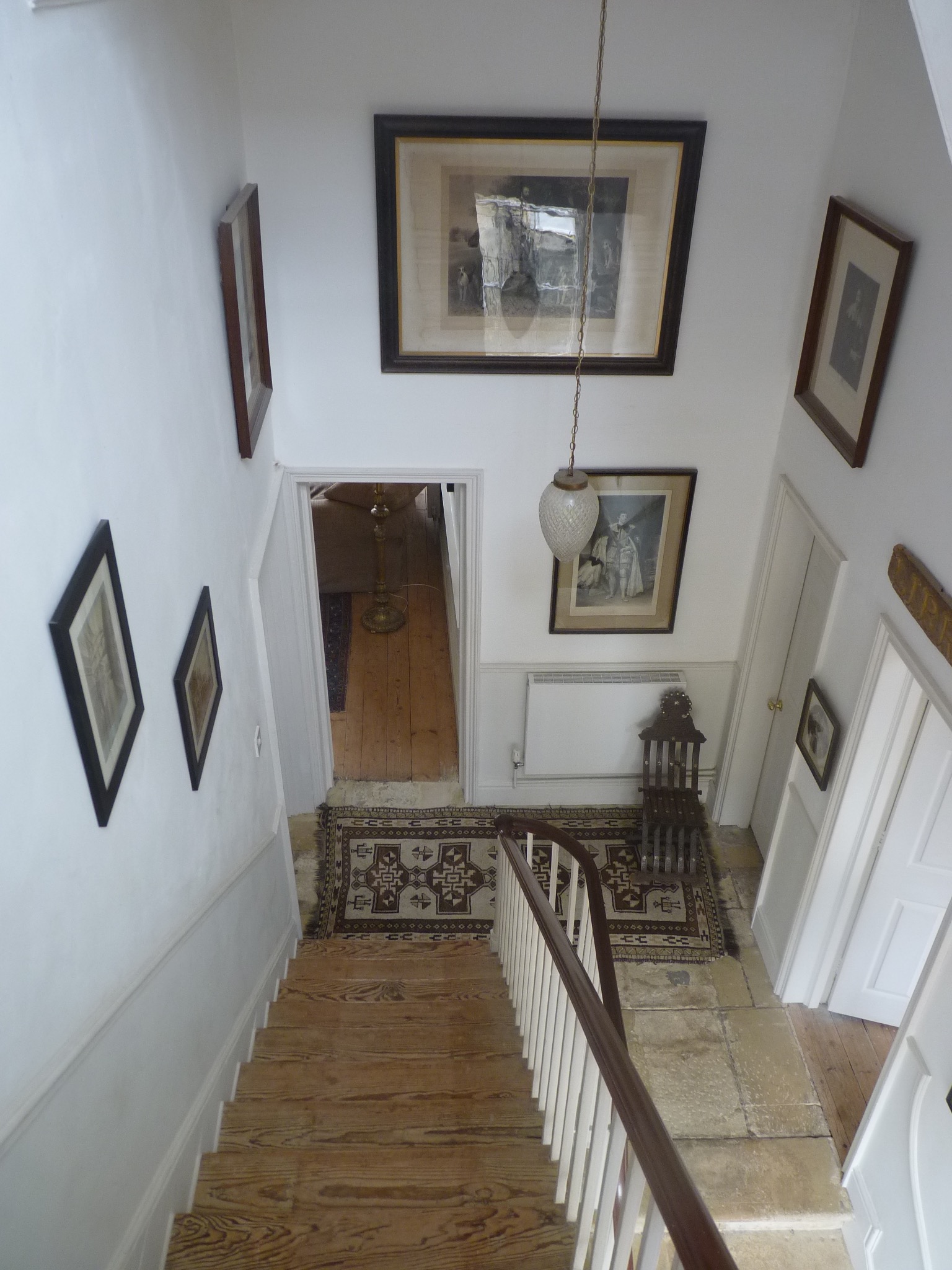
.
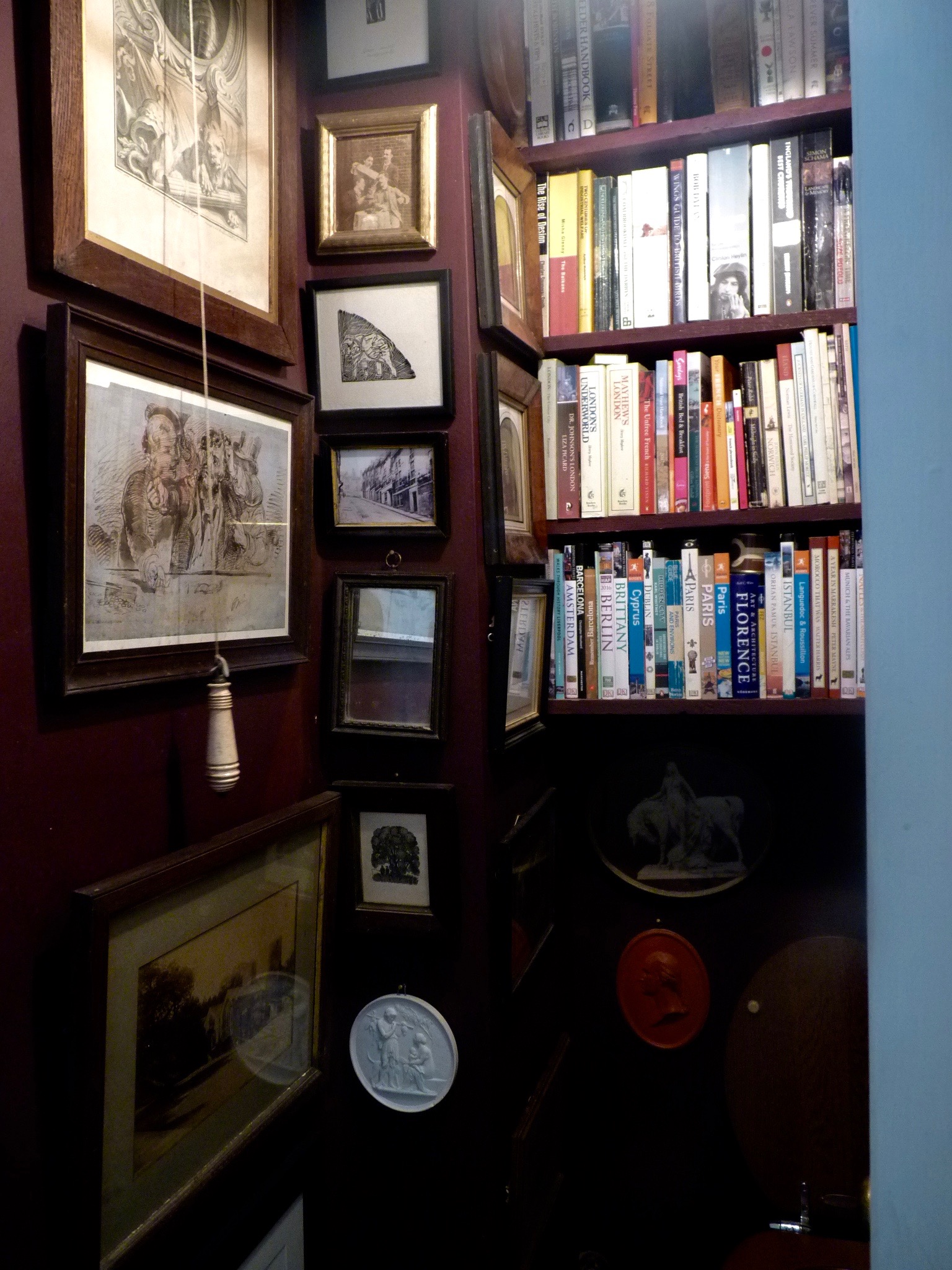
Did you collect things when you were little? ‘Birds eggs, cigarette cards, chewing gum cards, that sort of stuff – and of course I swopped them.’
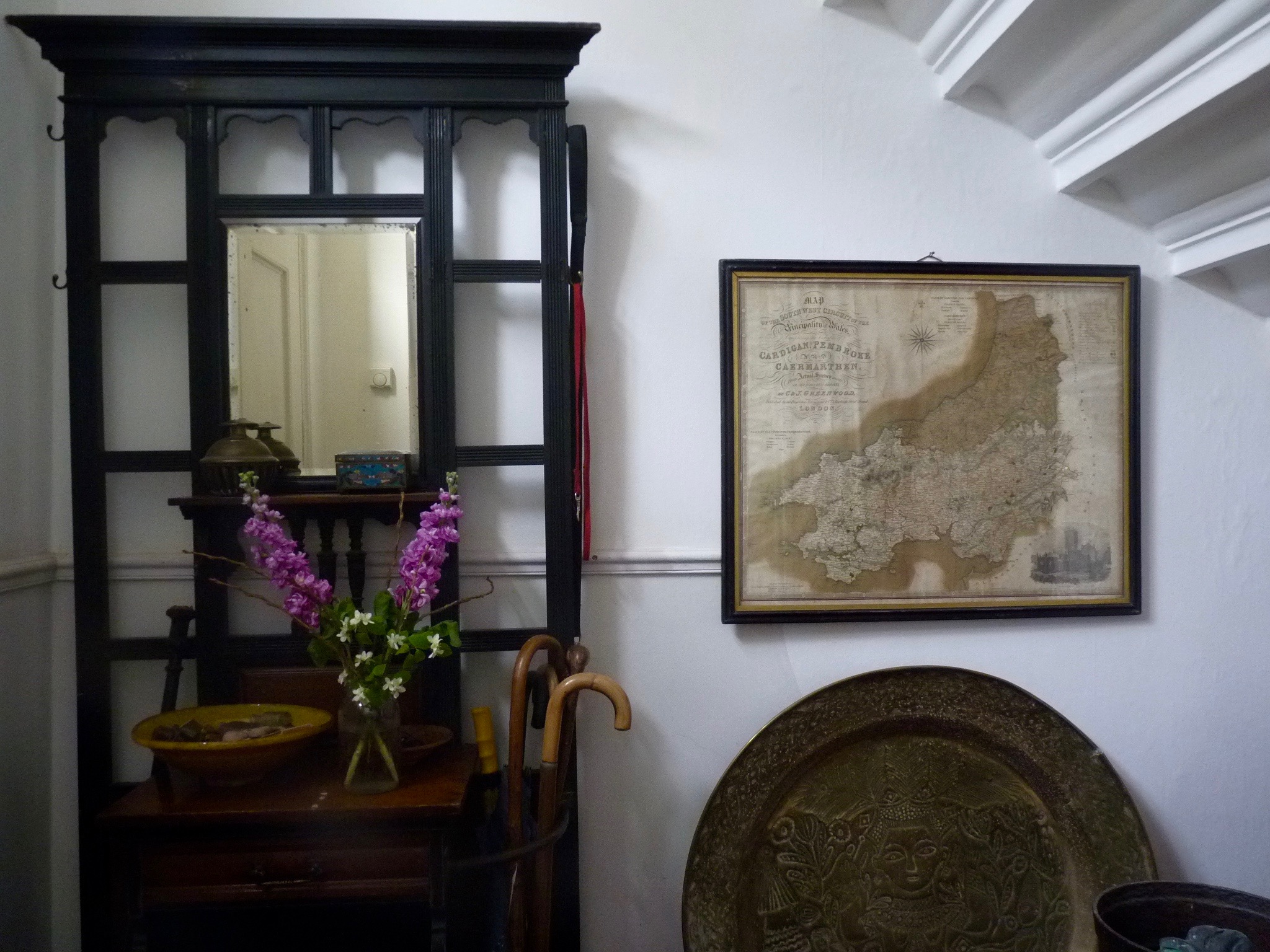
Just inside the front door, a very handsome hall stand.
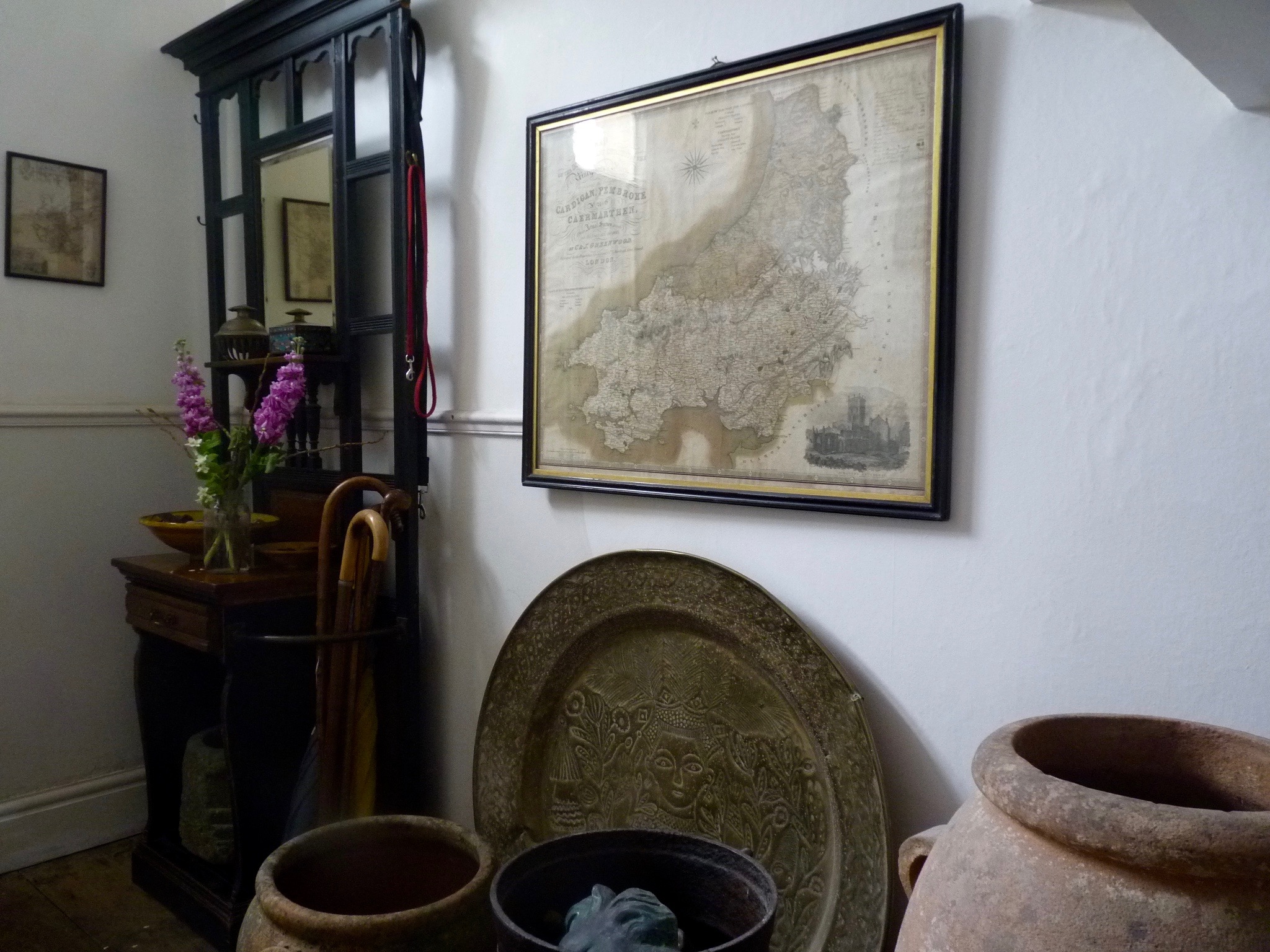
.
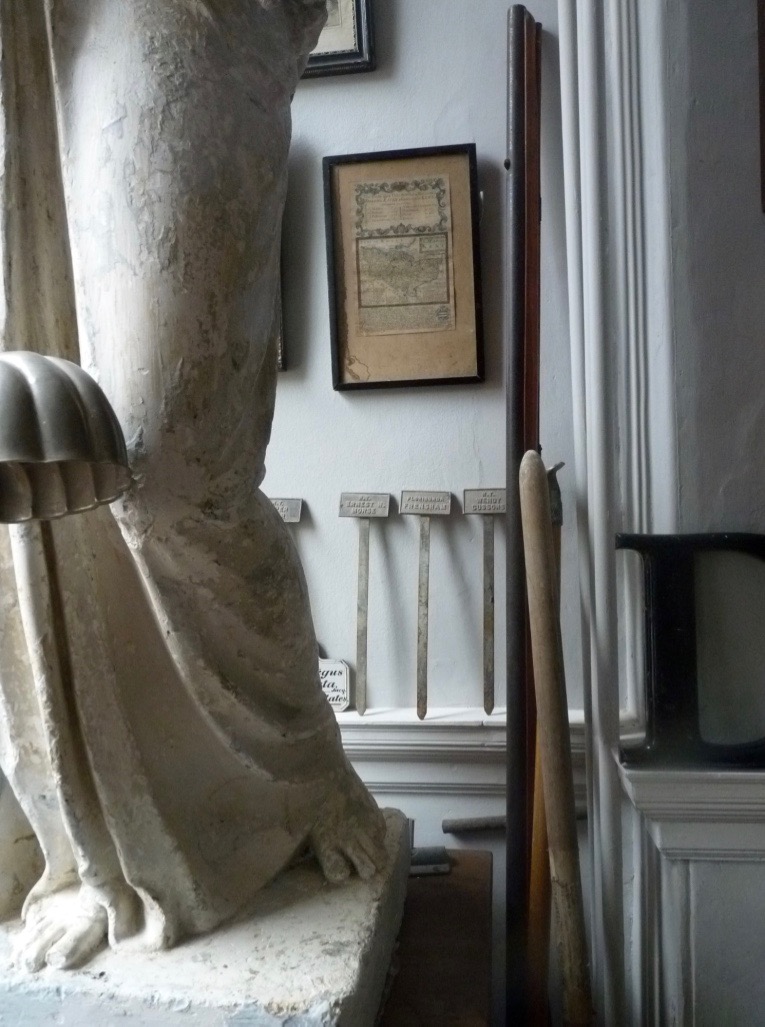
Very many thanks to David and his wife Sarah. David is on instagram too. He is a huge source of interesting knowledge and enthusiasms and so I offer this a as a sort of pictorial encomium to all that he knows.
Excerpts and links may be used, provided that full and clear credit is given to bibleofbritishtaste, with appropriate and specific direction to the original content.

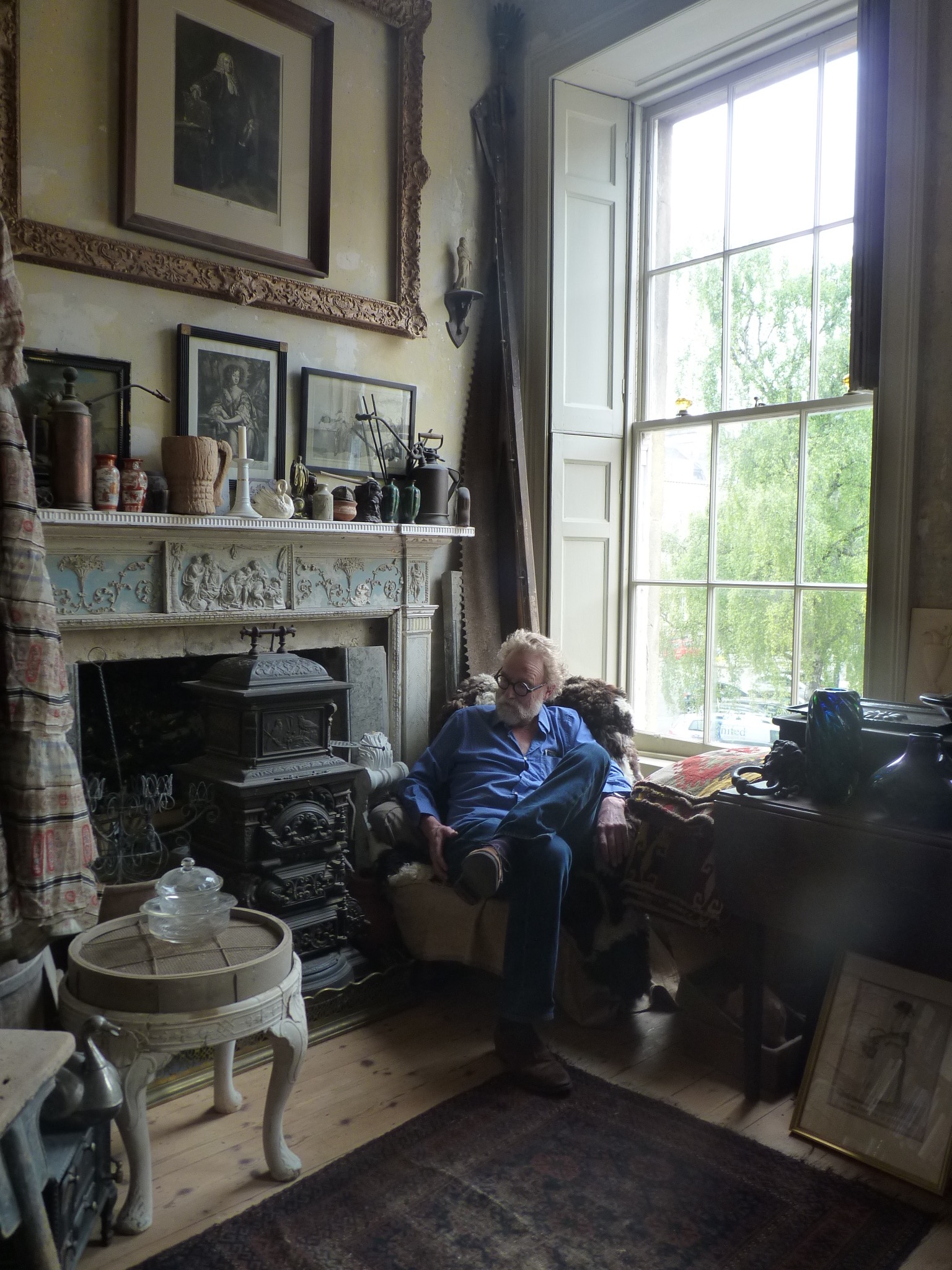
Thanks you made my sunday night
Phew! That was fun. Thank you.
Thanks so much for the tour of David’s fabulous collection. Absolutely wonderful.
Per the comment: Where did all the good stuff that there used to be – in every junk shop and street market – go? I wondered. ‘I think it all went to America,’ he says.’
Note: it did not go to America. Or if it did, we’re still looking for it, too.
Oh, Ruth, I have so enjoyed this virtual visit to a wonderful home with its very interesting owner. I love your photo – a portrait in itself – of David with the Renaissance tondo, it could be an ancestor of his!
I love those two-handled Wedgwood vases (this style copied, no doubt, by the Fulham Pottery and used as flower vases by Constance Spry, and surely, those two vases in the bathroom – with that splendid bath and shower – are Fulham pottery vases rather than Wedgwood).
However, there are so many lovely artefacts in this gorgeous house I would be here all day if I mentioned them all! I love the wall of assorted mirrors, so elegant! Walls of 1920s and 1930s mirrors are almost everywhere (I mean in house features in magazines) but this must be the most splendid collection of ornate mirrors – or perhaps I should say “looking glasses” – I have seen anywhere.
Thank you so much for visiting David Bridgwater in his lovely home. A pity Lulu, the terrier, didn’t appear to be photographed, too!
Margaret P
Just so wonderful, I am extremely thankful that David contacted you to mention his “nice house”. It is by far the most interesting house I have enjoyed looking at for years. Thank you for documenting it so wonderfully but most of all thank you to David for sharing his spectacular collections and home with us, we are very fortunate indeed!
Dear Ruth. What a fabulous house! You really must find out what was “particularly good” about the beautiful light fitting in the bathroom. I am curious! So glad your web site is up and running again. Reminds me of the wonders of Britain when I am back in Vancouver.
Great way to start the morning, and the week – one more week of work before vacation and I need something to keep me going for the last days;-)
I love the yellow-beige color in the dining room , alle the wonderful wedgwood vases – well everything actually. Keep it coming!!!
Thank you:-)
C
Another wonderful article, such a joy
What a wonderful house and collection – so uplifting seeing all those beautiful things and put together is such inspiring way. Makes me feel relieved that our house isn’t so cluttered after all!
I love this blog. It is the antidote to “decorator” magazines. It’s so nice to be reminded that really good houses have sagging shelves in the hutches.
As for the antiques, I think they got soaked up during the craze for them and now that (horribly) everything is streamlined and modern again, we’ll get another crack at them in the next 20 years.
Thank for you for this lovely and fascinating glimpse into Mr. Bridgwater’s remarkable world!
Thanks! What a beautiful house full of well-chosen things.
A fantastic house! So glad I had the opportunity to see it!!
so love that you are posting more, it’s ALWAYS riveting and a visual treat.
LOVE every bit of this house. A complete world in itself .
Hi Ruth – What a fabulous home. I am going to have to look at this several times to pick out all the bits and pieces. Thank you for keeping your blog going. I must say, it is one of my most favorites to read. Since I don’t travel much anymore, your blog is a delight to read and look at. I have learned so much.
Best,
Kristin
Thank you for this inpiring post, by far my favorite until now.
I absolutely love this house. I know this is a long shot but if by any teeny chance it might be possible to photograph it for an interiors magazine such as WoI , I would love to .. sincerely
Huntley Hedworth
You could try contacting him via his instagram account?
Oh I love this man’s home! Many, many things I love. My favorite is the old frames and old photos. I could spend hours looking at photos and other collectives! I wonder who many of the people are? Thank you for sharing such a wonderful home!
Dear Mr Bridgwater,
as a music historian I’m searching on a few portraits of George Frederic Handel. I read your fine articles about the portrait-bust which the ‘Händel-Haus’ in Halle/S. now possesses. I would like to ask you if you know anything about the provenance of the bust. Is it made by John cheere? Or later?
Best regards
Hans Joachim Marx, Hamburg.
[…] Instagramkontot Tat London som är min bästa anglofil-mysdos så hittade jag till Bible of british taste ett hemma hos i Bath. Det passar väl perfekt på en gråmulig men mysig lördag? Bilder från […]
An incredible, evocative collection , beautifully displayed. Thank you for providing us such a detailed look……..
Dear David
So lovely to see your wonderful collection once again. It been many years, but it would be great to chat and catch up with you once again.
Best wishes
Richard